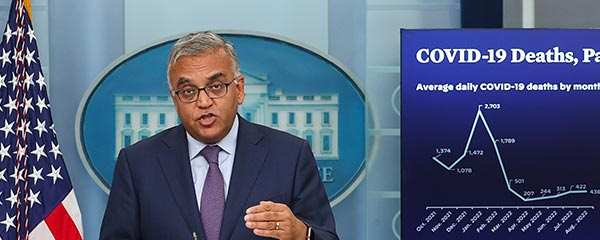Oct. 16, 2023
Americans spent much of 2022 and 2023 growing more positive in their assessments of the COVID-19 situation. But at summer’s end, they became a bit less confident and slightly more worried -- perhaps reflecting the rise in COVID-19 infections and emergence of new variants.
Americans Less Optimistic Heading Into Fall
In Gallup’s Aug. 29-Sept. 5 survey, 30% of Americans said the pandemic is “getting worse” -- up sharply from 5% in Gallup’s prior measure in late May/early June, and 8% in February. This is the highest rate of pessimism about the pandemic measured in over a year, since July 2022.
Pessimism still isn’t close to the overwhelmingly negative outlook seen in 2020. The largest share of adults still believes the coronavirus situation is improving or staying the same.
In the latest survey, about one in four Americans also express being either “very” (4%) or “somewhat” (23%) worried that they will catch COVID-19.
The 27% worried at least somewhat is up from 18% in May/June but still less than half the peak level of worry recorded during the pandemic in 2020.
While fewer Americans in August/September (53%) than in May/June (64%) believe the pandemic is over, the majority still say it is. Both of these readings are higher than Gallup found in 2021, 2022 or February 2023 (49%).
Meanwhile, there has also been no backslide in Americans’ reports of normalcy. Forty-two percent say their life is completely back to normal, and an equal proportion say their life is somewhat back to normal (43%).
Americans' COVID-19 Concerns Rise, but Still Restrained (Sept. 21, 2023)
In February, Gallup found 23% of Americans reporting they had avoided situations with large crowds, while 18% had avoided traveling by air or public transportation (bus, subway or train), 14% had avoided going to public places such as stores or restaurants, and 10% had avoided small gatherings of people.
Each of these avoidances was down significantly from the start of the pandemic.
At Year Three, Americans Split on Whether Pandemic Is Over (March 9, 2023)
Most Tested Positive at Some Point; a Wider Majority Has Protective Antibodies
Also in February, 52% of Americans reported that they had ever tested positive for COVID-19, and another 13% said they had not tested positive but believe they had had the coronavirus.
Self-reported infection was up significantly from the fall of 2022, when 44% said they had ever tested positive.
Gallup estimated that 83% of Americans may have some protective immunity against the coronavirus, either by being vaccinated (63%) or being unvaccinated but having tested positive for COVID-19 (20%).
Another 6% of Americans reported they have neither been vaccinated nor tested positive but believe they have had COVID-19. Assuming they are correct about that illness, that would leave 11% with no protective immunity against the virus as of February.
At Year Three, Americans Split on Whether Pandemic Is Over (March 9, 2023)
Gallup’s COVID-19 Data Resources
Links to all of Gallup's articles about the pandemic are available on this master list of COVID-19 news articles, sorted by topic.
The Gallup News homepage always features the latest findings from our ongoing COVID-19 research and offers helpful summary pages to direct you to specific content. These include:
- our COVID-19 topic page -- featuring every U.S., World and Workplace article we've published on the topic
- our Coronavirus Pandemic Topics A to Z page -- where you can find individual survey questions with full trends
This blog highlights the key insights drawn from our top news articles and is updated regularly. Please bookmark and visit often. If you are a member of the media interested in getting the latest updates on Gallup's COVID-19 coverage, or being notified when this page is updated, please write to us at media@gallup.com.
- The full list of all prior Gallup news articles on COVID-19, sorted by topic, is available here.
- Find all Gallup U.S., World and Workplace articles about COVID-19 on the COVID-19 topic page.
- Get data-driven insights and advice on how to lead your organization through the pandemic.
Nov. 29, 2022
Americans are more optimistic about the trajectory of the pandemic, are less worried about catching COVID-19 and are loosening measures they take to protect themselves, key Gallup indicators show.
Optimism About the Pandemic Increases; Many Say It Is Over
About two-thirds of Americans (65%) believe the COVID-19 situation in the U.S. is getting better, and 44% -- a new high -- now say the pandemic is over. Both readings are up by double digits since July when optimism was waning amid rising cases.
Though markedly improved, the current assessment of the coronavirus situation, from an Oct. 11-19 survey, is not nearly as optimistic as it was last year, in May and June 2021 after the original rollout of COVID-19 vaccines.
The percentage of Americans who think the pandemic is over has increased by 11 percentage points since July, with similar increases seen across all party groups. Still, Republicans are the only party with a majority saying the pandemic is over.
Additionally, previously unpublished Gallup data collected in October reveal that about two-thirds of Americans say that their socializing with friends and family (68%) and their shopping (64%) are now completely back to normal. Most also say that dining out (60%) has returned to the way it was before the pandemic.
Sixty-two percent of U.S. workers say that their work is completely back to normal. Meanwhile, small majorities of U.S. parents say that parenting (59%) and school (53%) are now back to the way they were before the pandemic.
Americans are mixed on their assessments of the normalness of entertainment and recreation (50%) and traveling (45%).
Less than half of Americans say their physical health (46%), personal finances (43%), outlook on life (41%) and mental health (40%) are completely back to normal.
Just 10% say that nothing in their lives is the way it was before the pandemic.
Meanwhile, one in three U.S. adults (33%) think President Joe Biden has communicated a clear plan in response to COVID-19 -- an eight-point decline from the previous reading in late 2021, and the lowest on record for Biden.
A similar 30% of Americans currently agree that the Centers for Disease Control and Prevention (CDC) has communicated a clear plan, also an eight-point decline from the prior reading.
Thirty-eight percent of U.S. adults agree that their own state governor has conveyed a clear COVID-19 plan, down four points from 2021 and the lowest for the trend. People living in states with Democratic governors are slightly more likely than those residing in Republican-led states to agree their governor has communicated a clear plan, 40% to 35%.
Pandemic Outlook Recovers as U.S. Leaders' Messaging Falters (Nov. 4, 2022)
Worries About Catching COVID-19, Social Distancing Efforts Both Down
Twenty-eight percent of Americans say they are very or somewhat worried they will get COVID-19 -- the lowest percentage Gallup has recorded since the summer of 2021.
About six in 10 Americans (59%) say they have made no attempt to isolate themselves from people outside their household in the past 24 hours -- the most eschewing social distancing since the beginning of the pandemic.
Seventy-eight percent of Americans, the highest to date, also say the best advice for people who do not have coronavirus symptoms and are otherwise healthy is to lead their normal lives as much as possible and avoid interruptions to work and business.
Worry About Catching COVID-19 Lowest Since June 2021 (Nov. 10, 2022)
Worries Among Workers Also Continue to Decline
About one in four employed adults (26%) say they are very or moderately concerned about being exposed to the coronavirus at work -- down from 33% when Gallup last measured this in July and from 36% a year ago. The rate was highest in July 2020, when 51% of employees were concerned.
Workers in the education field are the most likely occupation group to say they are very or moderately concerned about exposure to the coronavirus at work, followed by healthcare workers and then white-collar workers. Blue-collar workers are the least concerned.
One in Four Workers Still Fear Catching COVID-19 at Work (Nov. 22, 2022)
This blog highlights the key insights drawn from our top news articles and is updated regularly. Please bookmark and visit often. If you are a member of the media interested in getting the latest updates on Gallup's COVID-19 coverage, or being notified when this page is updated, please write to us at media@gallup.com.
Review Gallup's findings on all aspects of the COVID-19 crisis:
- The full list of all prior Gallup news articles on COVID-19, sorted by topic, is available here.
- Find all Gallup U.S., World and Workplace articles about COVID-19 on the COVID-19 topic page.
- Get data-driven insights and advice on how to lead your organization through the pandemic.
Past blog entries appear below.
____________________________________________________
Sept. 2, 2022
Pandemic optimists continue to outnumber pessimists in the U.S., as they have since February. However, the percentage who say the coronavirus situation is getting better fell 22 percentage points, to 41%, in Gallup's latest COVID-19 survey, conducted July 26-Aug. 2. At the same time, 30% say the situation is getting worse, and 29% think it is staying about the same.
The public senses trouble ahead, with two-thirds of Americans saying they expect there will be a surge in cases in the coming fall and winter months. While 53% of U.S. adults are worried about new strains of the COVID-19 virus spreading, just 35% are very or somewhat worried that they will get COVID-19.
Still, a 55% majority of U.S. adults report their lives are somewhat back to pre-pandemic normalcy, and 24% say they are completely back. However, 53% of Americans do not expect their lives will ever be the same as they were before the pandemic.
Americans Less Optimistic About COVID-19 Situation (Aug. 10, 2022)
In-Person Grocery Shopping, Dining Out Increasing
One sign that Americans are reclaiming some normalcy in their lives comes from consumer reports of their in-person grocery shopping and dining out. They report engaging in these activities about as often as they did before the pandemic. Gallup's annual July Consumption Habits survey also found online grocery shopping, which had increased last year, rose again this year, suggesting this trend may be here to stay.
In-Person Grocery Shopping Rebounds in U.S.; Online Also Up (Aug. 24, 2022)
Biden Rated Highest for COVID-19 Response
President Joe Biden received his best issue-specific job approval rating in August for his handling of the pandemic. It is the only issue of the 11 rated for which he received majority-level approval (58%). The COVID-19 response has typically been one of Biden's strongest issues.
Biden's Job Rating Rises to 44%, Highest in a Year (Aug. 25, 2022)
Vaccination of Youngest Children Lags Other Age Groups
While COVID-19 vaccines are available to all Americans 6 months of age and older, vaccinations in the youngest group are rare compared with all others, as 14% of U.S. parents of children under age 5 say their child has been vaccinated. Although 29% of parents say they plan to have their child under age 5 immunized, 57% do not intend to do so.
COVID-19 Vaccines Uncommon for U.S. Children Under Age 5 (Aug.19, 2022)
____________________________________________________
June 6, 2022
Gallup's latest updates on Americans' perceptions of the coronavirus pandemic found, at worst, no change in public concern since earlier in the year -- and at best, some lessening.
- Nearly two-thirds of Americans said the coronavirus situation in the country is getting better, unchanged from February, while a steady 12% said it is getting worse.
- Not quite a third (31%) said they are worried that they will get COVID-19, and a similar percentage (32%) said they are still avoiding large crowds. Both rates were down from February but still not as low as last summer.
- Half of U.S. adults reported wearing a face mask in the past seven days when away from home, the lowest since the start of the pandemic in 2020.
U.S. COVID Cases Are Rising Again, but Worries Are Not (May 11, 2022)
After polling about the pandemic monthly in 2021, Gallup has shifted to quarterly measurement in 2022. Look for the next update to be reported in August.
Still Feel in the Pandemic's Grip
At the same time that Americans' perceptions of the coronavirus situation brightened this spring, only a third were willing to say the pandemic is over. But this varied sharply by people's partisanship, with 66% of Republicans believing it's over versus 39% of independents and just 10% of Democrats.
Even if Americans believe the pandemic will someday end, fully half predict their lives will never get completely back to "normal." The rest are divided between thinking it already is back to normal (21%) or that normalcy will return in time (27%).
One in Three Americans Think Pandemic Is Over (May 23, 2022)
Requiring Masks on Planes Is Divisive
One obstacle to normalcy that currently divides Americans is requiring passengers to wear masks on planes. The public was evenly split in the latest poll over whether the federal government should (49%) or should not (51%) require everyone over age 2 to wear a mask when flying on an airplane. And when asked what they personally would do if they were traveling by air in the next few days, six in 10 said they would wear a mask while 40% said they would not.
Americans Divided on Face Masks When Flying (May 16, 2022)
Gallup senior editor Megan Brenan joined Gallup editor-in-chief Mohamed Younis on The Gallup Podcast in May to discuss Americans' stances on masks and other aspects of getting back to normal.
Many Are Dropping Their Guard (and Their Masks) on COVID (May 19, 2022)
Americans' Thriving Rate Dipped in First Quarter
At the start of the pandemic, Gallup saw Americans' description of their personal wellbeing tumble to the lowest it had been since the 2007-2009 recession. This is based on the percentage deemed "thriving" according to their current and future life ratings. The U.S. thriving rate subsequently recovered, reaching an all-time high in June 2021. But recent declines from that peak may partly reflect public discouragement stemming from the omicron variant, as well as the impact of rising inflation on people's lives.
In U.S., Life Ratings Drop to 13-Month Low (March 30, 2022)
____________________________________________________
March 21, 2022
The U.S. public's impression of the coronavirus pandemic has been anything but solid in 2022. Reflecting the trajectory of COVID-19 infections, Americans started the year highly pessimistic before turning highly positive in February.
- In the first half of January, 58% of U.S. adults thought the coronavirus situation in the U.S. was getting worse, while only 20% thought it was getting better.
- By mid-February, those figures had more than flipped, with 63% perceiving the situation as improving and just 12% as worsening.

Line graph. Percentages of Americans who think the coronavirus situation in the U.S. is getting a lot or a little better, staying the same, or getting a lot or a little worse, from April 2020 to February 2022. In the latest poll, 63% of U.S. adults said it is getting better, up from 20% in January. Twelve percent said it is getting worse, down from 58% in January and 25% say said it is staying the same, relatively unchanged.
Gallup's recent articles on this trend document these changes in perceptions about the pandemic in greater detail.
Pandemic Outlook in U.S. Drastically Improved (March 7, 2022)
Pandemic Pessimism Grows Amid Omicron Surge (Jan. 20, 2022)
Social Distancing Mirrors Coronavirus Concern
Meanwhile, Americans' personal behavior has also shifted, reflecting their varying levels of concern. As Gallup wrote earlier this month, "After dialing up their social distancing behaviors in January, Americans dialed them back down in February and are now the least cautious they have been since last July."
The March 9 article provides the specifics on how many Americans -- and which subgroups -- are still avoiding large crowds, public places and small gatherings as well as using a face mask for protection.
Social Distancing at Low Point on Pandemic Anniversary (March 9, 2022)
Biden's Job Approval Not Benefiting From Pandemic Improvement
Gallup's latest analysis of Joe Biden's job approval ratings, including for the coronavirus situation, shows that he is consistently rated better on his handling of the pandemic than on other issues, but that the trend mirrors his overall job rating more closely than it does the status of the pandemic.
Biden Ratings on Economy, Foreign Affairs, Russia Near 40% (Feb. 21, 2022)
Racial Disparity in Worry About COVID-19
In February, Gallup reported the findings of a West Health/Gallup study of over 6,000 U.S. adults exploring racial and ethnic differences in people's healthcare experiences, including how they have experienced the pandemic.
The study shows that Black and Hispanic adults are significantly more likely than White adults to feel very or somewhat stressed about getting infected with COVID-19.
Racial, Ethnic Divide in U.S. Views of Pandemic, Healthcare (Feb. 18, 2022)
____________________________________________________
Jan. 11, 2022
With the omicron variant of the coronavirus looming as a threat to the U.S., Gallup's final 2021 update to the COVID-19 Panel survey, conducted Nov. 29-Dec. 5, found Americans' outlook for the pandemic worsened considerably. This bleaker forecast for the pandemic came on the heels of a more optimistic view of the pandemic's trajectory in October.
Latest COVID-19 Wave Dents U.S. Optimism (Dec. 20, 2021)
Despite their more negative view of the pandemic, Americans' worry about contracting COVID-19 themselves remained steady, with 37% saying they were "very" or "somewhat" worried. About one month after the U.S. Centers for Disease Control and Prevention approved the Pfizer-BioNTech COVID-19 vaccine for children aged 5 to 11, the percentage of parents with children aged 18 and under worried about their children being infected with the virus fell three percentage points to 45% in the latest poll.
Parental Worry About COVID-19 Infection Eases Slightly (Dec. 17, 2021)
COVID-19 was named the most urgent health problem facing the U.S. for the second year in a row in Gallup's Nov. 1-16 Health and Healthcare poll. While the 47% naming COVID-19 is still a high percentage naming any health issue from a historical perspective, significantly fewer named it than in 2020 (69%).
COVID-19 Still Widely Named as Biggest U.S. Health Problem (Nov. 30, 2021)
COVID-19 Continues to Take Mental and Economic Toll
November's Health and Healthcare survey also found that Americans' mental health ratings were stable at a lower level than before the pandemic, suggesting that the ongoing coronavirus situation continues to take a toll on U.S. adults' wellbeing.
U.S. Mental Health Rating Remains Below Pre-Pandemic Level (Dec. 3, 2021)
The public's confidence in the economy is also flagging. Gallup's Dec. 1-16 poll found Americans' economic confidence had fallen to its lowest point since the early days of the pandemic, amid high inflation.
Economic Confidence in U.S. Matches Early Pandemic Low (Dec. 22, 2021)
Worker Burnout Higher Among Women; Support for Vaccine Mandates Continues
Meanwhile, Gallup's COVID-19 Panel survey found burnout among working women in the U.S. has grown during the pandemic, while it has dipped slightly among working men.
Gender Gap in Worker Burnout Widened Amid the Pandemic (Dec. 27, 2021)
Overall, a steady 36% of U.S. workers report that their employer has a vaccine requirement, and a majority continue to support such a measure.
Worker COVID-19 Vaccine Requirements Leveling Off (Dec. 15, 2021)
____________________________________________________
Nov. 16, 2021
Gallup's latest COVID-19 Panel survey, conducted Oct. 18-24, found a marked improvement in Americans' outlook for the pandemic as the surge in cases over the summer caused by the delta variant began to ease. U.S. adults' view that the COVID-19 situation is improving more than doubled between September and October, to 51% -- yet it remains well below the February through June range of 60% to 89%.
Americans More Optimistic About Pandemic's Trajectory (Nov. 3, 2021)
Vaccinations Steady Among Adults, Rising Among Children
Although the October survey found an unchanged three-quarters of U.S. adults saying they had received at least one COVID-19 shot themselves, an increased 55% of parents of 12- to 15-year-olds reported their child is at least partially vaccinated. This vaccination rate is roughly the same as the 58% of parents with children in the 16-to-18 age group who say their child is.
U.S. Adults' COVID-19 Vaccinations Steady, Teen Jabs Tick Up (Nov. 5, 2021)
Meanwhile, a steady 55% of parents of children younger than 12 said they would plan to have their child receive the COVID-19 vaccine once they are eligible. The survey was completed just before the U.S. Food and Drug Administration issued emergency use authorization of the Pfizer-BioNTech COVID-19 vaccine for children aged 5 to 11, and subsequent polling will explore how vaccinations are progressing for this age group.
Parents' Vaccination Intentions for Young Children Steady (Oct. 29, 2021)
Workplace Vaccine Mandates Are Up; Remote Work Preferences Persist
The October survey captured an increase in vaccine mandates at workplaces nationwide. Between July and October, the percentage of U.S. employees reporting that their employer is requiring all workers without a medical exemption to be vaccinated quadrupled to 36%. A 56% majority of employed U.S. adults are in favor of these mandates, and 37% are opposed.
COVID-19 Vaccine Now Required for 36% of U.S. Workers (Oct. 29, 2021)
With vaccination mandates in place, some employers who allowed workers to do their jobs remotely are now likely to require them to come into work at least sometimes. Yet, 45% of full-time workers say they are working remotely at least part of the time. While this has been steady in recent months, it is down from 69% early on in the pandemic. White-collar workers remain far more likely than blue-collar workers to be doing their jobs away from their workplaces.
Remote Work Persisting and Trending Permanent (Oct. 13, 2021)
Podcast: Returning to Work Amid Delta: What Employers Should Know (Oct. 1, 2021)
____________________________________________________
Oct. 5, 2021
The September update to Gallup's COVID-19 Panel survey finds Americans somewhat less pessimistic about the pandemic compared with the previous month. Although the latest 54% of U.S. adults who say the coronavirus situation is getting worse is still much higher than the single digits registered in May and June, it is 14 percentage points lower than August's 68%, which was the highest of 2021.
The latest data, from the Sept. 13-19 poll, reveal concurrent increases in the percentages of U.S. adults who think the pandemic is staying about the same (25%) or getting better (20%).

Line graph. Trend in Americans' assessments of the coronavirus situation. In the most recent survey from September, 54% of U.S. adults said the coronavirus situation was getting worse, 25% said it was staying the same, and 20% said it was getting better. The current assessment is an improvement since August when 68% who said it was getting worse.
Despite this slight improvement in outlook for the pandemic, Americans largely remain cautious in their behavior. Nearly three-quarters, 73%, say they have worn a face mask when outside their home within the past seven days, and 52% -- the highest since April -- say they have avoided large crowds. Likewise, the 46% who say they have avoided traveling by airplane, bus, subway or train within the past week is the highest since April.
The public doesn't expect a quick end to the disruption occurring to travel, school, work and public events in the U.S. More than eight in 10 Americans think the upheaval will continue through the end of 2022 (53%) or longer than that (30%). Less than 20% think it will end within a few months (16%) or weeks (2%). In contrast, in June, before the delta variant hobbled the United States' recovery from the pandemic, 83% of Americans thought it would be over by the end of 2021.
Vaccinations on the Rise; Majority Support for Mandates
Public health officials' focus has largely been on encouraging all Americans aged 12 and older to get fully vaccinated, and that has worked to some extent. Gallup finds that 75% of Americans aged 18 and older are at least partially vaccinated, while another 5% indicate that they intend to be immunized against COVID-19. This increase came on the heels of the U.S. Food and Drug Administration's full approval of the Pfizer-BioNTech vaccine as a steady 40% of Americans remain worried they will contract the disease.
More in U.S. Vaccinated After Delta Surge, FDA Decision (Sept. 29, 2021)
There is overall approval for President Joe Biden's mandates requiring millions of U.S. workers to be vaccinated against COVID-19. About six in 10 Americans support vaccination requirements for federal government workers, employees of large companies, and workers at hospitals that receive federal healthcare funds. Support for requiring companies to give employees paid time off to get vaccinated or to recover from vaccine side effects is even higher, at 68%.
Majority in U.S. Supports Biden COVID-19 Vaccine Mandates (Sept. 24, 2021)
Majority of Parents of Children Under 12 Will Get Them Vaccinated
Meanwhile, a steady 55% of parents in the U.S. say they would get their child under 12 vaccinated when a vaccine is available for that age group. Pfizer and BioNTech recently applied for emergency use authorization for their vaccine for that age group. Fifty-three percent of parents are worried about their child contracting COVID-19, and those with school-aged children remain divided in their views on mask mandates in schools.
In U.S., 55% Would Get COVID-19 Vaccine for Young Child (Sept. 28, 2021)
____________________________________________________
Sept. 13, 2021
The latest update to Gallup's COVID-19 Panel survey, conducted Aug. 16-22, found Americans' outlook on the coronavirus pandemic in the U.S. is worsening as the delta variant continues to cause a surge in cases, hospitalizations and deaths. The rising number of cases, particularly in Southern states, has resulted in hospitals being overrun. As such, in just one month's time, U.S. adults' worry about hospital capacity and supplies has grown from 16% to 39%.
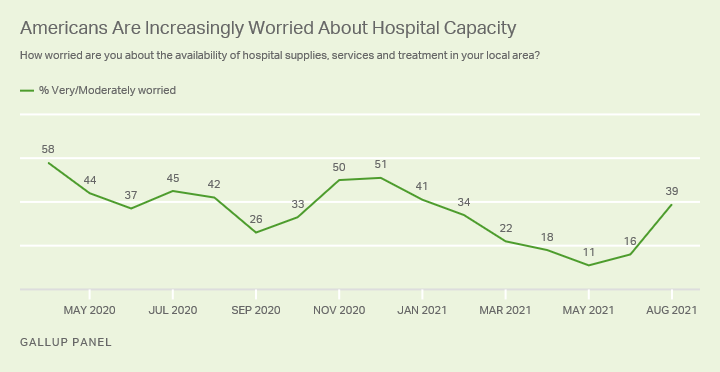
Line graph. Percentage of Americans who are very or moderately worried about the availability of hospital supplies, services, and treatment in their local area, since April 2020. The latest 39% is up from 16% in July and 11% in May. The highest on record was 57% in April 2020.
Americans' Views of Pandemic Worsen and Take on Renewed Urgency
Americans have become increasingly worried about the coronavirus situation in the U.S., as 68% now say it is getting worse, up from 3% in June. With concern about contracting COVID-19 on the rise as well, some of the public's social distancing behaviors are also escalating.
Two-Thirds in U.S. Now Say COVID-19 Situation Worsening (Sept. 1, 2021)
These concerns about COVID-19 have resulted in its return to the top spot on the list of most important problems facing the country, now mentioned by 26% of U.S. adults. Satisfaction with the direction of the country has also taken a hit after showing improvements in the spring.
U.S. Satisfaction Drops; COVID-19 Resurges as Top Problem (Aug. 24, 2021)
Ratings of CDC, Biden, Governors Deteriorate Amid Surging Cases
Americans' ratings of leaders for their communication of a clear plan in response to the pandemic have worsened. In the first reading since the Centers for Disease Control and Prevention issued new guidance that unvaccinated people should wear masks, more U.S. adults now disagree than agree that the CDC has communicated a clear plan of action. Ratings of President Joe Biden's communication of a clear plan are sharply divided, and while state governors are rated more positively than negatively for their communication, it is their worst reading on record.
Americans' Ratings of CDC Communication Turn Negative (Sept. 7, 2021)
Public More Supportive of Vaccine Requirements
The director of the CDC has said it is now "a pandemic of the unvaccinated" as the surge in cases is occurring primarily among those who have not been vaccinated against COVID-19. Americans have become more supportive of requiring proof of vaccination to participate in certain public activities. This includes majorities who favor such mandates to travel by airplane, stay in a hotel, attend events with large crowds, dine in a restaurant and go to work.
Update: American Public Opinion and Vaccination Requirements (Sept. 3, 2021)
Specifically, more than half of U.S. workers support vaccine mandates at their workplace, and reports of their implementation doubled between July and August. About one in five U.S. workers reported in August that their employers have vaccine mandates in place. These data were collected and reported before the Biden administration's announcement that it would require larger employers to have their employees vaccinated against, or be tested weekly for, COVID-19.
Twice as Many U.S. Workers Say Work Requiring COVID Vaccine (Sept. 8, 2021)
Workers Have Strong Views on Vaccine Mandates; More in Favor (Aug. 18, 2021)
Schools Mask Mandates Divisive; Satisfaction With Education Remains High
While there is some consensus on vaccine mandates, requiring face masks in schools remains a polarizing issue. K-12 parents tilt more toward requiring masks than not, but the level of support for universal mask mandates for students, teachers and staff is below the majority level. However, majorities of parents do agree that at least unvaccinated students and staff members should be masked at school.
K-12 Parents Divided Over Mask Mandates in School (Aug. 31, 2021)
____________________________________________________
Aug. 13, 2021
In Gallup's previous roundup, Americans' assessments of the COVID-19 situation were becoming much more positive. But views have taken a sharp turn as the delta variant of the virus has spread across the U.S., driving new cases, hospitalizations and deaths upward.
Gallup's recent data illustrate Americans' renewed negative outlook.
Optimism, Confidence Suffer as Delta Variant Spreads
In a dramatic shift from the previous month, more Americans now say the coronavirus situation in the U.S. is getting worse (45%) rather than better (40%). In June, a record-high 89% said the situation was getting better, while only 3% said it was getting worse.
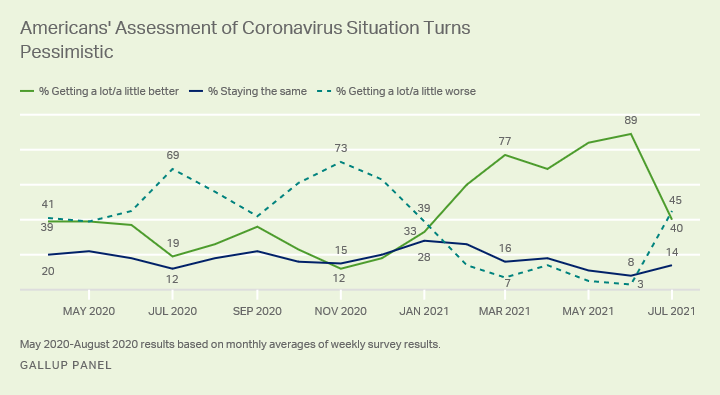
Line graph. Americans' assessments of the coronavirus situation in the U.S. as getting better, staying the same or getting worse. Forty percent of Americans in July 2021 say the situation is getting better, 45% worse and 14% saying the same. Americans had been more positive than negative since February. In 2020, they were more likely to say things were getting worse, including a high of 73% in November.
Americans' Optimism About COVID-19 Dashed as Cases Surge (Aug. 2, 2021)
Americans have become less confident that they can protect themselves from catching the coronavirus while in public. The percentage who are "very confident" fell to 38% in July after rising to a pandemic high of 51% in May and remaining near that level, at 50%, in June.

Line graph. Trend from March 2020 to July 2021 in percentage of Americans who are very confident that they can protect themselves when out in public from being infected by the coronavirus. Percentage was at its lowest, 10%, in March 2020. It rose to 28% by June of that year before declining to 19% in the fall. It rose back to 26% in January 2021, 35% in March and 51% in May. It stayed at 50% in June before falling to 38% in July.
Americans Less Confident They Can Elude COVID-19 (Aug. 3, 2021)
In July, the percentage of Americans citing the coronavirus as the most important problem facing the United States rose slightly to 12%, after having dipped to a trend low of 8% in June.
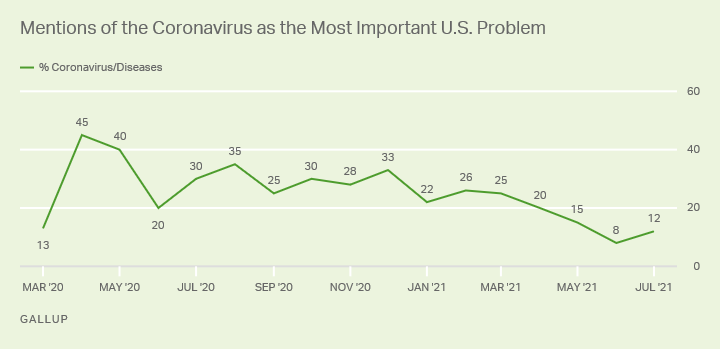
Line graph. Trend in the percentage of Americans who mention the coronavirus as the most important problem facing the U.S. Twelve percent of Americans in July 2021 cite COVID-19 as the most important problem facing the country.
Coronavirus Ticks Up as Most Important U.S. Problem (July 30, 2021)
About One in Five Remain Vaccine-Resistant
Just under one in five U.S. adults, 18%, can be described as vaccine-resistant. These Americans say they would not agree to be vaccinated if a COVID-19 vaccine were available to them right now at no cost and that they are unlikely to change their mind about it. The percentage holding these views has been stable in recent months. Another 5% of Americans would not agree to be vaccinated but say they are at least somewhat likely to change their mind.
| May 18-23, 2021 | Jun 14-20, 2021 | Jul 19-26, 2021 | |
|---|---|---|---|
| % | % | % | |
| Already vaccinated | 64 | 68 | 69 |
| Plan to get vaccinated | 12 | 8 | 8 |
| Would not agree to be vaccinated; very/somewhat likely to change mind | 5 | 4 | 5 |
| Would not agree to be vaccinated; not likely to change mind | 19 | 20 | 18 |
| Gallup Panel | |||
About One in Five Americans Remain Vaccine-Resistant (Aug. 6, 2021)
Supply Chain Disruptions Affect Most People; Food Habits Shift
Americans have felt the global supply chain disruptions wrought by COVID-19, with most reporting difficulty in receiving goods this summer. Sixty percent of U.S. adults say they have been unable to get a product they wanted in the past two months because of shortages, and 57% have experienced significant delays in receiving a product they ordered. Seven in 10 Americans overall have had at least one of these issues, while 46% have had both.
| Yes | |
|---|---|
| % | |
| Inability to get a product due to shortages | 60 |
| Significant delays in receiving a product you ordered | 57 |
| Summary | |
| Experienced one of the two problems | 71 |
| Experienced both problems | 46 |
| Gallup Panel, July 19-26, 2021 | |
Most U.S. Consumers Have Felt Supply Chain Problems (Aug. 11, 2021)
The COVID-19 pandemic has changed many things about the way Americans live, including how they get food. Several notable shifts have occurred in this area since 2019, before the coronavirus upended the public's daily routines. More U.S. adults are ordering groceries online today, and fewer are making frequent visits to grocery stores. In addition, fewer Americans than two years ago are dining at restaurants, but takeout and delivery from restaurants remain common. At the same time, the use of food preparation kits has not changed meaningfully.
More in U.S. Grocery Shopping Online, Fewer Dining Out (Aug. 10, 2021)
Mixed Ratings for CDC's Communication
In recent months, the public has been more positive than negative about communications from the Centers for Disease Control and Prevention, including in a late July measure that found 39% agreeing and 32% disagreeing that the agency has communicated a clear plan of action to deal with the coronavirus. This most recent reading preceded the controversy over the agency's renewed call for vaccinated Americans to wear face masks in public.

Line graph. Agreement and disagreement that the Centers for Disease Control has communicated a clear plan of action in response to the coronavirus. In June 2020, Americans were divided with 33% agreeing and 32% disagreeing. By September, opinion had turned more negative than positive, with 41% disagreeing and 25% agreeing. Opinion was divided in October 2020 through December 2020, before becoming negative again in January 2021. Since March, opinion has been more positive than negative, including 39% agreement and 32% disagreement, similar to the readings in most months.
CDC Communication Ratings Mixed During Pandemic (Aug. 9, 2021)
Most Support School Mask Mandates, but Parents Less Supportive
Majorities of Americans support mask mandates in schools for unvaccinated students and staff members. They likewise think middle and high school students should be required to receive a COVID-19 vaccine to attend in-person classes.
However, parents with students in kindergarten through 12th grade are significantly less supportive of each measure. These results were largely obtained before medical and public health experts called for face-mask requirements in schools regardless of vaccination status in late July.
U.S. K-12 Parents Support Mask Mandate, Divided on Vaccines (Aug. 3, 2021)
Gallup Analysts on the Latest COVID-19 Data
Tune in to hear Gallup Senior Editor Jeff Jones breaking down the dramatic turn in Americans' attitudes about the COVID-19 situation.
Podcast: 'Massive Shift' in COVID-19 Sentiments as Delta Spreads (Aug. 5, 2021)
After reviewing a number of surveys examining vaccine-hesitant Americans and what might be done to encourage more vaccination, Dr. Frank Newport, a Gallup senior scientist, writes, "Three conclusions appear to be justified." Read about these conclusions in Newport's recent "Polling Matters" blog post.
Vaccine Hesitancy and U.S. Public Opinion (July 30, 2021)
____________________________________________________
July 13, 2021
COVID-19 is taking less of a toll on Americans than it had over the previous year, with U.S. adults and children bouncing back emotionally and some adults even living their best lives.
U.S. adults are less likely to say COVID-19 is the greatest problem facing the country, smaller percentages of Americans are completely or mostly isolating themselves from people outside their household, and close to one in three would go so far as to say the pandemic is "over." Meanwhile, more U.S. adults are considered to be thriving than at any point in Gallup's life evaluation trend -- and their daily emotional experiences, as well as their children's, are improving.
COVID-19 Becomes Less Burdensome on Americans
Fewer than one in five Americans (18%) now say they are completely or mostly isolating themselves from nonhousehold members, down from 75% near the onset of the pandemic in April 2020.
Conversely, almost half of Americans, 47%, now say they made no attempt whatsoever to isolate themselves from nonhousehold members in the past day.
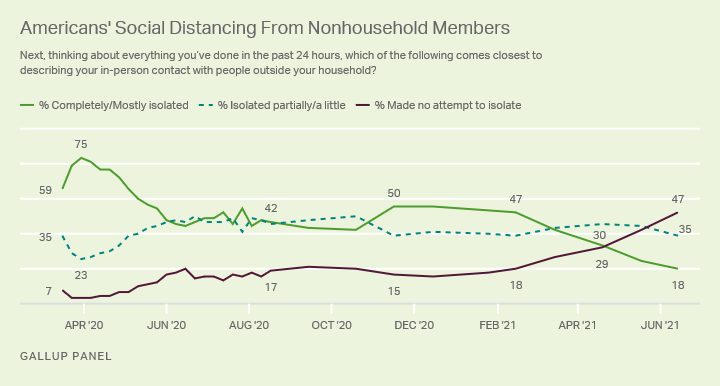
Line graph. Trend from March 2020 to June 2021 in Americans' self-reports of how much they are isolating from nonhousehold members out of concern about the coronavirus. After spiking to 75% in April, the percentage completely or mostly isolated in the past 24 hours fell to below 40% for much of last summer, then rose to closer to 50% from November through February but has since declined and is now 18%.
Strict Social Distancing in the U.S. Dwindles to 18%
Just 8% of Americans now mention the coronavirus pandemic as the most important problem in the U.S., the lowest point since it began. The highest percentage citing COVID-19 was 45% in April 2020, which is among the highest recorded by Gallup for any single issue in the past two decades.
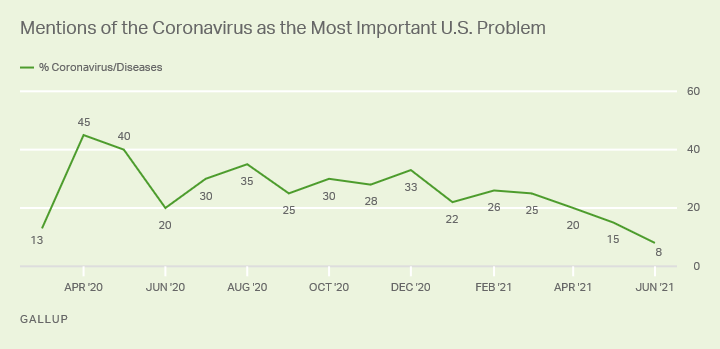
Line graph. Percentage of Americans mentioning the coronavirus as the most important problem facing the U.S., trend since March 2020. In June 2021, 8% mention COVID-19, the lowest on record, and a percentage that has been steadily declining since March 2021. The high of 45% was in April 2020.
Sharply Fewer in U.S. Cite COVID-19 as Nation's Top Problem
Most Americans are not yet ready to declare the pandemic over in the U.S., but about one in three say it is over (29%). Republicans are far more likely than Democrats to say the pandemic is over, but significant differences also exist by gender, age and region of the country.
| Yes, pandemic is over | No, is not over | |
|---|---|---|
| % | % | |
| U.S. adults | 29 | 71 |
| Gender | ||
| Male | 36 | 64 |
| Female | 22 | 78 |
| Party identification | ||
| Republican | 57 | 43 |
| Independent | 35 | 66 |
| Democrat | 4 | 96 |
| Age group | ||
| 18-34 years old | 24 | 76 |
| 35-54 years old | 32 | 68 |
| 55 and older | 30 | 70 |
| U.S. region | ||
| Northeast | 23 | 77 |
| Midwest | 31 | 69 |
| South | 31 | 69 |
| West | 28 | 72 |
| GALLUP PANEL, June 14-20, 2021 | ||
Three in 10 Americans Think Pandemic Is Over in U.S.
A Resurgence in 'Thriving' U.S. Life Evaluations
The percentage of Americans who evaluate their lives well enough to be considered "thriving" on Gallup's Life Evaluation Index reached 59.2% in June, the highest in over 13 years of ongoing measurement. During the initial COVID-19 outbreak and economic shutdown, the thriving percentage plunged nearly 10 percentage points to 46.4% by late April 2020, tying the record low last measured during the Great Recession.

Line graph. The percentage of Americans who evaluate their lives highly enough to be considered thriving from 2008 until June 2021. Currently, a record-high 59.2% of Americans rate their lives highly enough to be considered thriving.
Americans' Life Ratings Reach Record High
U.S. children are experiencing far less boredom and less worry, stress and anger today than they did at the start of the pandemic, according to parents' reports of their children's emotions. Meanwhile, enjoyment and happiness continue to be prevalent among children, with little change since March 2020.
U.S. adults say their own emotions have improved even more starkly. Their self-reports of boredom and all of the negative emotions measured are down significantly from March 2020, while their reports of enjoyment and happiness have increased.
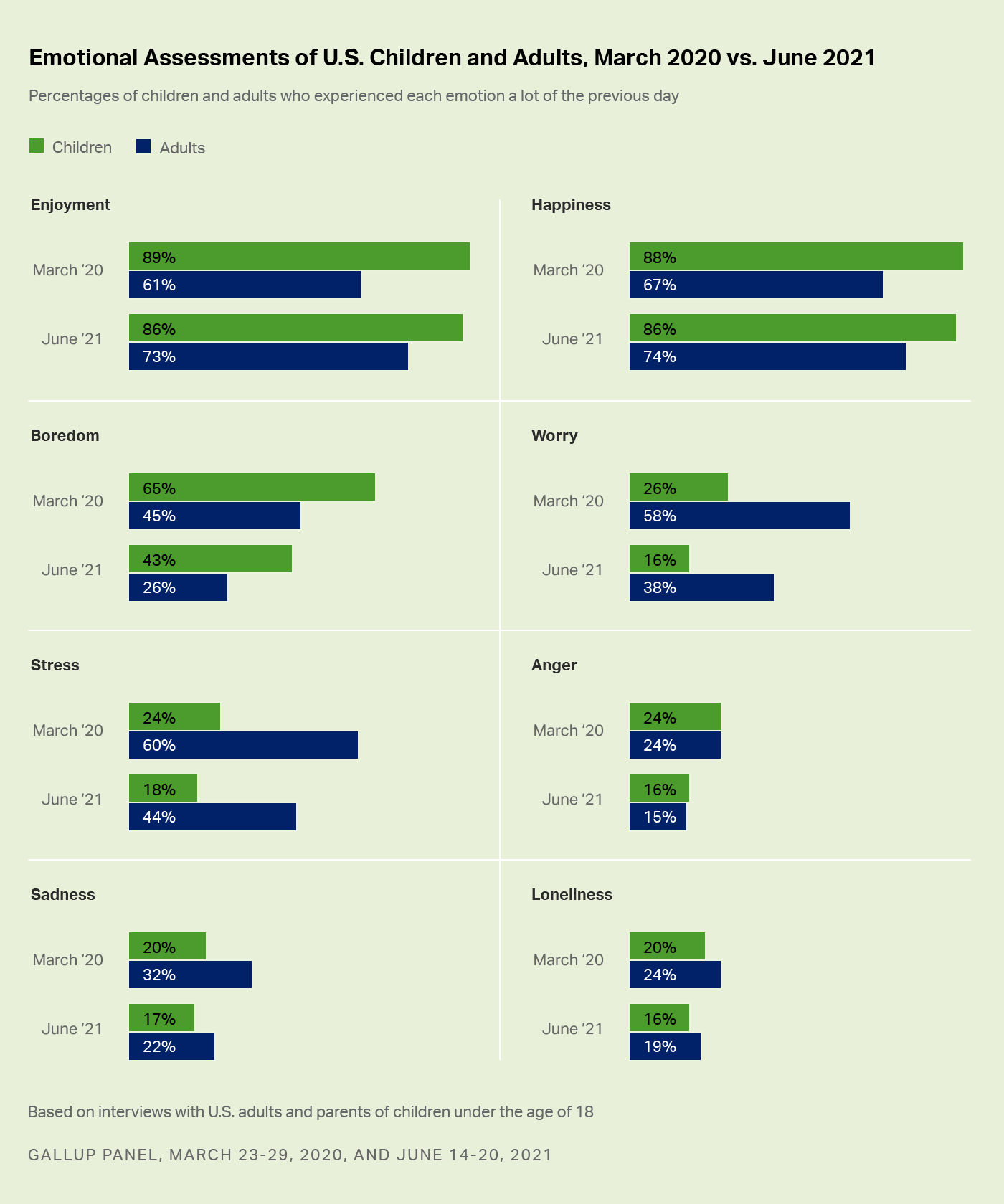
Bar chart. U.S. adults' reports of themselves and their minor children experiencing eight emotions -- enjoyment, happiness, boredom, worry, stress, anger, sadness, and loneliness -- during a lot of the previous day in March 2020 and June 2021. Both adults and children feel more positive now than at the start of the pandemic.
As Pandemic Begins to Fade, So Too Does Children's Boredom
How Did the Gallup World Poll Overcome Pandemic Challenges to Polling?
Gallup was conducting face-to-face interviews in sub-Saharan Africa -- but then the COVID-19 pandemic hit. Jay Loschky and Magali Rheault, Gallup's regional directors for sub-Saharan Africa, join The Gallup Podcast to discuss polling during a global health crisis and what they found in their research.
Gallup Gains Insights Into African Life During the Pandemic
____________________________________________________
June 17, 2021
Now that a majority of U.S. adults have been fully vaccinated against COVID-19, Gallup's most recent COVID-19 tracking survey, conducted May 18-23, finds Americans are more likely to report a resumption of some semblance of their normal lives. Although fewer than one in 10 U.S. adults say their lives are "completely" back to normal, 57% say they are "somewhat" so.
Optimism about the trajectory of the pandemic continues to rise, as a record-high 84% of Americans say the situation is getting better. The public is also markedly less worried about contracting the disease.
For the first time since the pandemic began, a majority of Americans say the best advice for healthy people is to lead their normal lives rather than stay home to prevent the spread of COVID-19.
U.S. Life Becomes Quasi-Normal as Virus Fears Fade (June 4, 2021)
The survey findings suggest that the public is doing exactly that. Self-reported social distancing has fallen to its lowest point of the pandemic, and far fewer Americans are avoiding a number of social activities out of concern about the disease. Meanwhile, they are visiting restaurants and shopping in greater numbers. Yet, the public is still exercising caution when it comes to some activities, such as avoiding going to events with large crowds -- over four in 10 are still doing so. And while face mask usage outside the home is down, close to eight in 10 still report having worn a mask in the past week.
Americans Getting Out More, but Cautiously (June 7, 2021)
Americans' in-person attendance at religious services has also begun to pick up as houses of worship have lifted capacity restrictions. Yet, even as in-person attendance has increased, overall attendance remains lower in 2021 than it was in 2019.
In-Person Religious Service Attendance Is Rebounding (June 2, 2021)
Americans' Attitudes About Vaccines
The percentage of Americans who say they have already been vaccinated against COVID-19 or plan to be remains stable at 76%. Most of those who say they do not plan to receive the immunization are steadfast in their refusal, as about four in five of them report that they are unlikely to reconsider their decision.
COVID-19 Vaccine-Reluctant in U.S. Likely to Stay That Way (June 7, 2021)
With the COVID-19 vaccine's eligibility extended to children aged 12 and older, a slim majority of Americans support requiring proof of vaccination to attend middle school. Even more Americans think high school and college students should have to be vaccinated before returning to the classroom.
Public Backs Requiring COVID-19 Vaccine to Attend School (June 11, 2021)
____________________________________________________
May 28, 2021
Remote Work Situation
Though many coronavirus restrictions have been lifted in recent weeks, workers have not flooded back to their workplaces. Currently, 45% of U.S. full-time workers are working remotely -- essentially unchanged from 47% in April, but down slightly from earlier this year and 2020 when about half of workers were working remotely.
Fifteen percent of all full-time workers who work for an employer are doing their jobs remotely now but would like to go back to their workplaces. This percentage has been fairly steady over the past year.
Meanwhile, 30% are working remotely and prefer to do so as much as possible even after health restrictions are lifted. When asked why, the vast majority of these workers -- 90%, which equates to 27% of all U.S. workers -- say they simply prefer to work remotely. A dwindling share of workers -- now just 3% -- say they prefer to work remotely because of concerns about the coronavirus. Last July, 18% of U.S. workers wanted to work remotely as much as possible due to coronavirus fears.
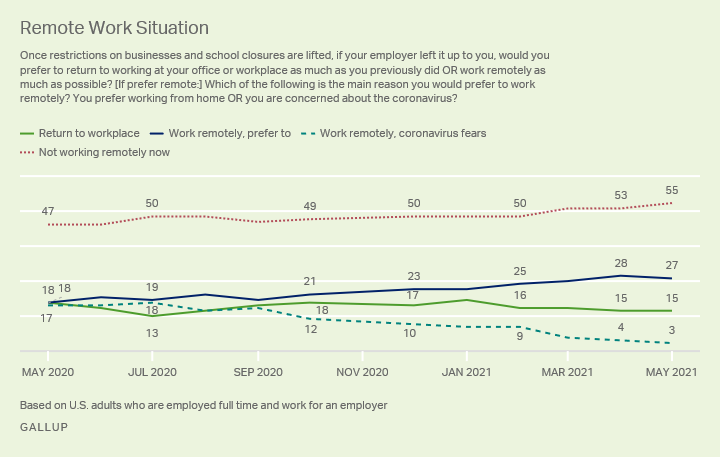
Line graph. Trend in remote work preferences. Over time, the percentage of full-time U.S. workers who are not working remotely has increased from 47% to 55%, with much of that change occurring since February. Fifteen percent currently are working remotely but want to return to working in their workplace, a percentage that has been fairly stable during the pandemic. Twenty-seven percent are working remotely and want to continue to do so because the prefer it, a percentage that has increased from 18% in the earlier stages of the pandemic. Now just 3% are working remotely and prefer to because of concerns about the coronavirus, a percentage that had been 18% a year ago but has declined over time.
Prior Gallup research found that remote work is common among white-collar workers -- with more than seven in 10 doing so -- though the percentage is higher in some fields than others. Well over half of those working in computers, finance, media and science express a desire to continue working remotely as much as possible.
____________________________________________________
May 14, 2021
Gallup's latest monthly update on U.S. attitudes about the coronavirus pandemic found Americans feeling the most encouraged yet about the vaccine rollout and the least worried about contracting COVID-19. The poll was conducted April 19-25, as U.S. COVID-19 infections were stable at just over 60,000 new cases per day -- similar to the March numbers -- but as the vaccination rate was rapidly climbing.
Not only were 76% of all Americans satisfied with how the vaccination process was going in the country in April (up from 68% in March), but there was also bipartisan agreement, with 68% of Republicans, 70% of independents and 87% of Democrats feeling satisfied.
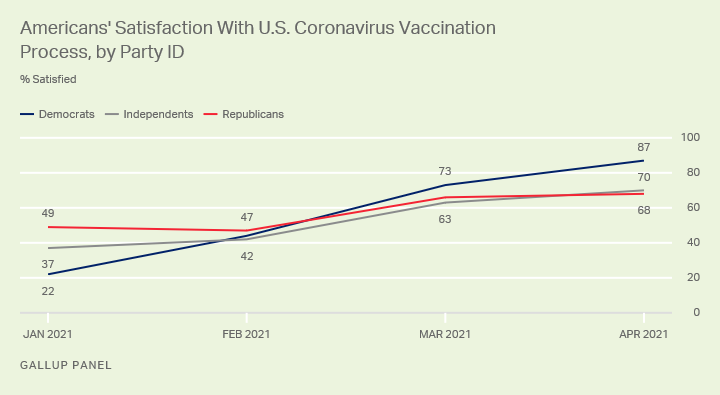
Line graph. Monthly trend by month from January 2021 to April 2021 in Republican, independent and Democratic satisfaction with how the COVID-19 vaccination process is going in the U.S. Democratic satisfaction has risen from 21% in January to 86% in April while Republican support has increased from 49% to 69% over the same period. Satisfaction among independents about doubled, rising from 37% to 70%.
Americans were also far more likely in April to worry about people in their area being unwilling to get vaccinated (55%) than to worry about their local vaccine supply (15%).
In U.S., More Worry About Vaccine Demand Than Supply (May 5, 2021)
Dwindling Fear of Contracting COVID-19
With a majority of respondents now reporting that they are at least partially vaccinated against COVID-19, public worry about contracting the virus is the lowest to date. Just 30% of Americans said in April that they are very or somewhat worried they will get COVID, down from 35% in March and 49% in February. As recently as January, when cases were at their highest of the pandemic, 57% of Americans were worried.
Worry About Contracting COVID-19 Hits New Low in U.S. (May 13, 2021)
Public mentions of the coronavirus as the nation's No. 1 problem in April were at their lowest since last June, at 20% -- down from 25% in March and 33% in December. COVID-19 still ranks as one of the top issues of concern to Americans, at a time when relatively few mention the economy, unemployment, healthcare or other key domestic issues.
Fewer in U.S. Cite Coronavirus as Most Important Problem (April 28, 2021)
Vaccine Passports Get Mixed Reviews
Being vaccinated against the coronavirus is poised to become a condition of entry into public places going forward, although the legality of the U.S. government or private companies requiring this is still unclear, and could vary by locale based on state and local laws.
Gallup probed the issue, asking Americans whether they favor or oppose requiring proof of vaccination in each of five settings. Majorities said they favor it in two, both involving people being in close quarters: air travel and attending events with large crowds. Majorities oppose it for three others: dining out, staying in a hotel and going to their workplace. People's vaccination status plays a large role in these attitudes.
U.S. Support for Vaccination Proof Varies by Activity (May 7, 2021)
| Favor | Oppose | ||||||||||||||||||||||||||||||||||||||||||||||||||||||||||||||||||||||||||||||||||||||||||||||||||
|---|---|---|---|---|---|---|---|---|---|---|---|---|---|---|---|---|---|---|---|---|---|---|---|---|---|---|---|---|---|---|---|---|---|---|---|---|---|---|---|---|---|---|---|---|---|---|---|---|---|---|---|---|---|---|---|---|---|---|---|---|---|---|---|---|---|---|---|---|---|---|---|---|---|---|---|---|---|---|---|---|---|---|---|---|---|---|---|---|---|---|---|---|---|---|---|---|---|---|---|
| % | % | ||||||||||||||||||||||||||||||||||||||||||||||||||||||||||||||||||||||||||||||||||||||||||||||||||
| Travel by airplane | 57 | 43 | |||||||||||||||||||||||||||||||||||||||||||||||||||||||||||||||||||||||||||||||||||||||||||||||||
| Attend events with large crowds, such as sporting events or concerts | 55 | 45 | |||||||||||||||||||||||||||||||||||||||||||||||||||||||||||||||||||||||||||||||||||||||||||||||||
| Go to your worksite to do your job* | 45 | 55 | |||||||||||||||||||||||||||||||||||||||||||||||||||||||||||||||||||||||||||||||||||||||||||||||||
| Stay in a hotel | 44 | 56 | |||||||||||||||||||||||||||||||||||||||||||||||||||||||||||||||||||||||||||||||||||||||||||||||||
| Dine in at a restaurant | 40 | 60 | |||||||||||||||||||||||||||||||||||||||||||||||||||||||||||||||||||||||||||||||||||||||||||||||||
| *Among those employed full or part time | |||||||||||||||||||||||||||||||||||||||||||||||||||||||||||||||||||||||||||||||||||||||||||||||||||
| Gallup panel, April 19-25, 2021 | |||||||||||||||||||||||||||||||||||||||||||||||||||||||||||||||||||||||||||||||||||||||||||||||||||
A Landmark Examination of the Global Impact of COVID-19
On May 3, Gallup released its 2020 World Poll findings on how much people's lives in 116+ countries and areas have been affected by the pandemic, including loss of work, specifically. On average, 45% of adults in these countries said the situation has affected their lives "a lot" -- but this varied widely by country, ranging from a high of 67% in Kenya to a low of 10% in Laos. Nearly one in three workers worldwide reported losing their job or business, equivalent to an estimated 1 billion adults.
Global COVID-19 Coverage (May 3, 2021)
COVID-19 Affected People's Lives Everywhere (May 3, 2021)
COVID-19 Put More Than 1 Billion Out of Work (May 3, 2021)
Gallup also reported on global rates of willingness to get vaccinated as well as handwashing during the pandemic. On average, more than two in three were willing to be vaccinated, but this varied a great deal across countries. More than half reported washing their hands with soap and water or using hand sanitizer at least five times a day, but this is hampered by limited access to water -- and soap or sanitizer -- in many locations.
Over 1 Billion Worldwide Unwilling to Take COVID-19 Vaccine (May 3, 2021)
How Often Do People Wash Their Hands During a Pandemic? (May 3, 2021)
____________________________________________________
April 6, 2021
As the nation's vaccination rate continues to tick up and new daily cases of COVID-19 remain lower than they were at their highest levels in January, Gallup's latest COVID-19 tracking survey documents solid improvements in Americans' attitudes about various aspects of the pandemic.
A record-high 77% of U.S. adults in the March 15-21 survey said the coronavirus situation in the U.S. is getting better, and their levels of concern about contracting the virus (35%) and about access to hospital services/treatment (22%) and COVID-19 tests (14%) fell to record lows.
Americans' Worry About Catching COVID-19 Drops to Record Low (April 6, 2021)
Shifting Views of COVID-19 Vaccine
Americans have also become far more satisfied with the vaccine rollout in the U.S., with satisfaction rising to 68% in March, double the January reading. Majorities of all major demographic subgroups now register satisfaction.
Willingness to be immunized against COVID-19 has also edged up, to 74% -- the highest point of the pandemic. Nineteen percent of U.S. adults said they are fully vaccinated, 13% are partially vaccinated, and 42% plan to get vaccinated but have not yet done so. The 26% who say they would not agree to be vaccinated is the lowest by three points since July.
Although at least slim majorities of Americans in all major demographic subgroups express willingness to receive a COVID-19 vaccine, older Americans, Democrats, college graduates and those with annual household incomes of $90,000 or more are significantly more likely than their counterparts to say they have already received it or want to do so.
Most Americans appear to be following the guidance of the Centers for Disease Control and Prevention that recommend continuing to wear masks when in public. With near unanimity, those who are already at least partially vaccinated are just as likely as those who are not vaccinated but plan to be to say they have worn a mask outside their home in the past seven days.
Satisfaction With U.S. Vaccine Rollout Surges to 68% (March 30, 2021)
Evolving Social Distancing Behaviors
The March survey captured a decrease in social distancing behaviors, which is directly linked to increased vaccination rates. Americans who are fully vaccinated are much less likely than those who are partially vaccinated or who plan to get vaccinated to say they are isolating themselves from others. Likewise, those who are vaccinated are increasingly likely to report going to stores, restaurants, other people's homes and their workplace.
Social Distancing Behaviors Drop as U.S. Vaccinations Rise (March 31, 2021)
Continued Support for Return to In-Person School
As frustrated parents around the nation have been vocally pushing for a return to the classroom, citing concerns about the damage to their children's academic progress, psychological health and social development, the public's appetite for in-person education remains high. Seventy-four percent of U.S. adults, including 79% of K-12 parents, support in-person schooling in their community. A slightly smaller 67% of Americans favor in-person college classes.
| Yes, support | |||||||||||||||||||||||||||||||||||||||||||||||||||||||||||||||||||||||||||||||||||||||||||||||||||
|---|---|---|---|---|---|---|---|---|---|---|---|---|---|---|---|---|---|---|---|---|---|---|---|---|---|---|---|---|---|---|---|---|---|---|---|---|---|---|---|---|---|---|---|---|---|---|---|---|---|---|---|---|---|---|---|---|---|---|---|---|---|---|---|---|---|---|---|---|---|---|---|---|---|---|---|---|---|---|---|---|---|---|---|---|---|---|---|---|---|---|---|---|---|---|---|---|---|---|---|
| % | |||||||||||||||||||||||||||||||||||||||||||||||||||||||||||||||||||||||||||||||||||||||||||||||||||
| In-person schooling for K-12 students | 74 | ||||||||||||||||||||||||||||||||||||||||||||||||||||||||||||||||||||||||||||||||||||||||||||||||||
| In-person schooling for college students | 67 | ||||||||||||||||||||||||||||||||||||||||||||||||||||||||||||||||||||||||||||||||||||||||||||||||||
| GALLUP PANEL, March 15-21, 2021 | |||||||||||||||||||||||||||||||||||||||||||||||||||||||||||||||||||||||||||||||||||||||||||||||||||
Approval of COVID-19 Aid Package Sharply Polarized
Although a majority of Americans overall (63%) approve of the 2021 American Rescue Plan Act passed by Congress and signed into law by President Joe Biden, support for it is politically divided. Nearly all Democrats (97%), about six in 10 independents (58%) and fewer than one in five Republicans (18%) approve of the roughly $2 trillion aid package. This contrasts with the 2020 CARES Act, which had the backing of strong majorities across party lines.
COVID-19 Aid Package Both Popular and Controversial (March 26, 2021)
COVID-19 and U.S. Workers
Gallup has tracked how the pandemic has disrupted work life in the U.S. over the past year using a number of measures. Since April 2020, roughly four in five workers have consistently said they are doing their job differently. More than one-third of adults in that group say the disruption has made their job more difficult. Although remote work has declined since last spring, 58% of U.S. workers continue to do their job remotely at least some of the time.
And while workers initially gave their employer high marks for effective communication at the start of the pandemic, their assessments have worsened as the pandemic has worn on.
How Has the Pandemic Affected U.S. Work Life? (March 17, 2021)
Working women during the pandemic suffered greater job losses than men. Employed women were more likely than men to say that their own mental health suffered during the pandemic, and working women also reported slightly more stress and worry than their male counterparts.
Life Evaluation Slips More for U.S. Working Women Than Men (March 22, 2021)
____________________________________________________
March 12, 2021
A year after the pandemic took hold in the U.S. and led to nationwide lockdowns to prevent the spread of the disease, Gallup finds the highest level of optimism about the COVID-19 situation to date. Gallup's latest polling, from Feb. 14-21, also finds 71% of Americans saying they plan to get vaccinated, including 16% who had received at least one dose of a COVID-19 vaccine.
Majority Now Says COVID-19 Situation Getting Better
For the first time, a majority of Americans, 60%, believe the COVID-19 situation in the U.S. is getting better. As recently as November, 73% said the situation was getting worse. Changes in assessments of the COVID-19 pandemic are strongly related to the changes in the number of coronavirus infections, and February saw a steep decline in infections compared with large increases in November and December.
Americans' personal worry about the disease has eased slightly, with 49% now saying they are very or somewhat worried about getting COVID-19, down from the high of 58% in November and matching the lows from June and September.
Still, Americans believe the disruptions caused by the pandemic will remain for some time, with 52% predicting they will persist into the second half of 2021.
Greater Satisfaction With the Vaccine Rollout
With increasing numbers of adults getting the vaccine, Americans are now more likely to express satisfaction with how the vaccine process is going in the U.S. Forty-four percent are satisfied, up from 34% in January. Still, more are dissatisfied (56%) than satisfied.
Americans who have been fully vaccinated from the coronavirus -- who had received both doses of the vaccines available at the time of February interviewing -- are less inclined than those who have not been fully vaccinated to say they are mostly or completely isolating themselves from others.
Because the proportion of U.S. adults who have been fully vaccinated remains small, the group's more relaxed attitudes toward social distancing have not done much to reduce the overall percentage of Americans who are taking such measures. Forty-seven percent of all Americans in February, compared with 50% in December, say they are mostly isolating themselves from others.
Parents Want Children Back in School
Gallup finds 79% of parents of children in grades K-12 favor in-person schooling for elementary and secondary school students in their community right now. This includes solid majorities of working and nonworking parents; those in all regions of the U.S.; and Republicans, independents and Democrats. Political leaders have made in-person schooling a priority, but many districts continue to educate their students through remote learning methods.
Economic Impact
Americans' assessments of the national economy remain significantly worse than they were before the pandemic, but not nearly as bad as they were in its initial stages. Gallup did, however, find an uptick in February in mentions of economic issues as the most important problem.
Meanwhile, Americans' ratings of the current state of their personal financial situation have not changed much since last spring. However, over the past year, Americans have expressed considerable anxiety about how their finances might change.
Women have been disproportionately affected by the decline in the job market compared with men. A major reason for this is that women are more likely than men to be employed in the types of jobs that have been more affected by the pandemic. Leaving work to provide child care for remote learners is another factor, while differential concern about being infected with the coronavirus does not appear to be a reason for the gender discrepancies.
At the one-year anniversary of the U.S. national coronavirus emergency, Gallup finds relatively positive ratings of President Joe Biden for his handling of the pandemic, improved personal life evaluation ratings from Americans, and higher worker engagement with their jobs.
____________________________________________________
Feb. 24, 2021
In late January, a majority of Americans (56%) reported they were maintaining their avoidance of small gatherings, similar to the recent peak in this precautionary behavior that Gallup recorded at the tail end of 2020. This is based on Gallup's Jan. 25-31 COVID-19 tracking survey as new daily cases were dropping after the post-holiday peak -- but stay tuned for more recent figures from the monthly update in February.
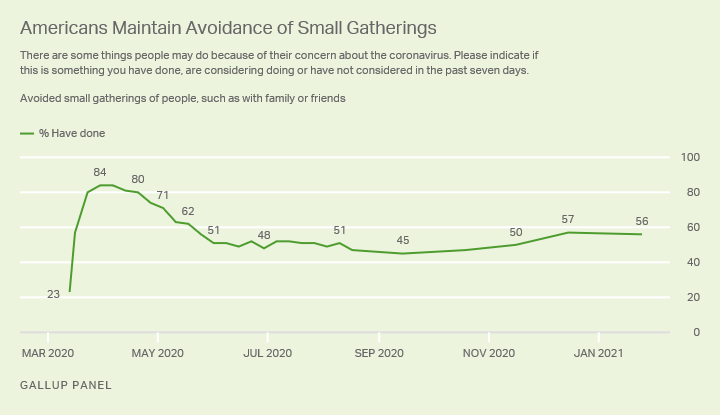
Line graph. Americans' avoidance of small gatherings due to concern over COVID-19. 56% of Americans say the have avoided small gatherings of people over these concerns, in February. This is essentially unchanged from the 57% who said the same last month.
Most Americans Dissatisfied With Vaccine Rollout
The late January survey found 66% of Americans were dissatisfied with the COVID-19 vaccination process in the U.S.
Meanwhile, 71% of Americans said they were willing to be vaccinated, up from 65% in late December and the highest recorded since July. The January figure included 62% who said they would be willing to be vaccinated if it were available to them right now at no cost and 9% who said they had already received at least one of the two doses needed to be fully inoculated. Those resistant to receiving the vaccine were divided in their reasons, but concerns about its safety and a general distrust of vaccines were chief among them.
Two-Thirds of Americans Not Satisfied With Vaccine Rollout (Feb. 10, 2021)
According to an analysis of data from the Franklin Templeton-Gallup Economics of Recovery Study, 49% of healthcare workers and first responders said in December that they would agree to receive the vaccine and 34% said they would not, with another 18% unsure. These front-line workers were about as likely as workers in other sectors to say they would agree to get a COVID-19 vaccine that was free, widely available, FDA-approved and at least 90% effective.
Front-line Workers No Keener Than Others to Get Vaccine (Jan. 26, 2021)
COVID-19 Disruption Seen as Lasting Longer Than Before
More than half of Americans, 53%, see the disruption due to COVID-19 lasting past the middle of 2021, up from 33% who said the same in late December. This is largely due to a shift away from perceptions that the disruption would be over by mid-year, with 37% of the U.S. public saying the situation will have improved by then -- a substantial drop from the 55% who previously said so. Relatively few Americans expect the disruption to last a few more months or less.
Majority in U.S. See COVID-19 Disruption Well Into 2021 (Feb. 17, 2021)
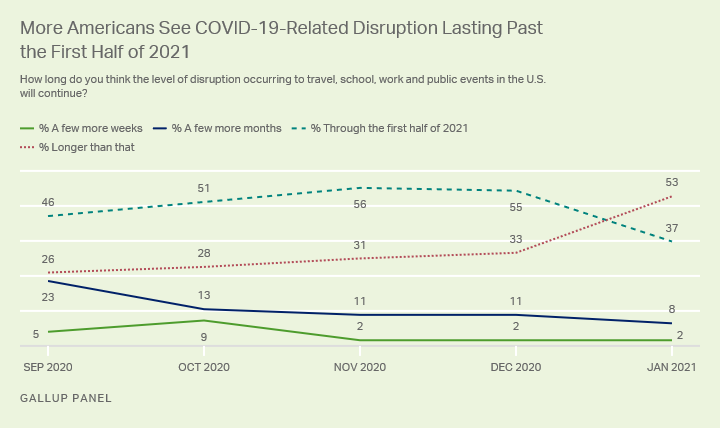
Line graph. Americans' views on how long disruption from COVID-19 will last. 53% now say disruption will last past the first half of 2021, while 37% say through the first half of the year, 8% believe it will continue for a few more months and 2% say a few more weeks.
Remote Work Still the Norm for Most U.S. Workers
A solid majority of U.S. workers, 56%, continue to report they are working remotely all or part of the time to avoid catching or spreading the coronavirus.
When Gallup first asked workers last April whether they were working remotely, the rate was at its high point of 70%. It dwindled in each subsequent month before leveling off in September.
Majority of U.S. Workers Continue to Punch In Virtually (Feb. 12, 2021)
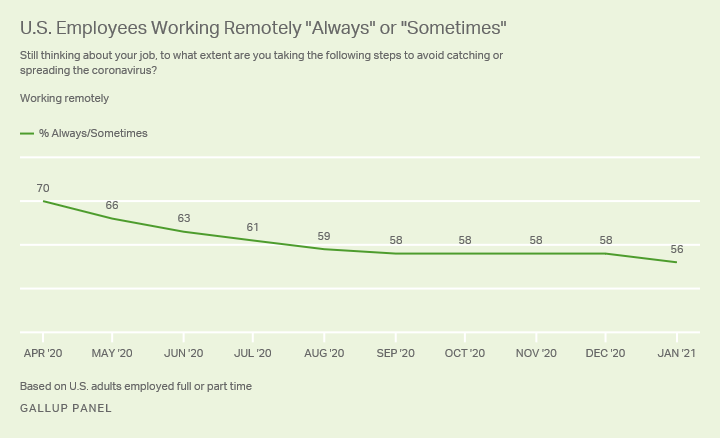
Line graph. The percentage of U.S. adults work remotely all or some of the time to avoid COVID-19. 56% of Americans say they are now working remotely some or all of the time, little changed from 58% in December of last year.
Listen to Gallup's senior workplace strategist, Dr. Adam Hickman, talk about remote work strategies, isolation, wellbeing and how to stay productive as remote work extends into 2021 for many Americans.
Remote Work: What Works and What Doesn't (Feb. 12, 2021)
A study by the Carnegie Corporation and Gallup highlights Americans' widespread concern about job losses resulting from the COVID-19 pandemic. Overall, Americans were most likely to choose access to healthcare and the economy/job loss among the most important issues currently facing the nation, from a list of eight. When asked which of those eight issues have become more urgent in recent months, however, they were most likely to choose the economy and job loss (76%).
Job Losses Underpin Support for Jobs-and-Training Initiative (Feb. 17, 2021)
Americans' views of how their personal financial situation changed over the past year dropped precipitously in early 2021, reflecting the impact of the coronavirus pandemic on these perceptions. After hitting a record high in January 2020, the percentage of U.S. adults saying they are financially better off than they were a year ago tumbled 24 percentage points to 35%, the lowest reading since 2014. At the same time, 36% said they are worse off and 28% volunteered that their situation is the same.
Americans' Views of Their Financial Situation Worsen (Feb. 3, 2021)

Line graph. Americans' assessment of their current financial situations. 36% say they are better off now financially than they were a year ago, while 35% say they are worse off.
Polling at a Global Level During a Pandemic
Last year, the COVID-19 pandemic forced Gallup to rethink how we survey the world. Since 2005, Gallup has conducted the majority of World Poll surveys through face-to-face interviews -- which was neither safe nor possible to do in most places in 2020, and still isn't today.
After concluding that we could safely transition from in-person interviews to computer-assisted telephone interviews and still maintain the data quality that meets Gallup's standards, that switch was made. Using Gallup's highly experienced regional polling teams around the world, surveys were conducted in 116 countries and areas in 2020.
What Gallup Is Learning About Polling the World in a Pandemic (Jan. 26, 2021)
____________________________________________________
Jan. 20, 2021
The latest update to Gallup's ongoing COVID-19 tracking survey was conducted Dec. 15-Jan. 3 as coronavirus cases and deaths surged in the U.S. and Americans began to receive their first vaccinations against the disease. During this period, the percentage of Americans who reported that they had avoided small gatherings in the past week rose seven percentage points to 57%, the highest level since late May.
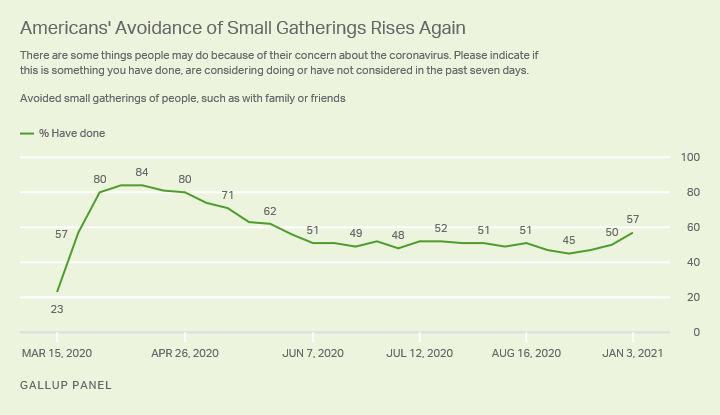
Line graph. Americans' self-reports of their avoidance of small gatherings in the past seven days since mid-March. The latest 57%, from Dec. 15-Jan. 3 polling marks a seven-point increase from the prior month.
At the same time, Americans' self-reports of their in-person contact with people outside their household remained steady, with half saying they were completely (15%) or mostly (35%) isolating themselves and the other half saying they were isolating partially (23%), only a little (14%) or not at all (14%).
There was also no change in the 69% of U.S. adults who said the better advice right now for people who do not have COVID-19 symptoms and are otherwise healthy is to "stay home as much as possible" rather than "lead their normal lives as much as possible and avoid interruptions to work and business" (31%).
While Americans remained pessimistic about the trajectory of the coronavirus situation, the percentage who say the situation is getting worse fell 10 points to 63% from the previous reading in November. An analysis shows a correlation between the percentage growth in COVID-19 cases from the prior month and the public's assessment of the situation.
U.S. Pessimism About COVID-19 Situation Eases Slightly (Jan. 18, 2021)
Willingness to Be Vaccinated Not Universal
The rollout of COVID-19 vaccines in the U.S. was met with a public that is largely willing to receive them -- roughly two-thirds indicated they would do so. Yet, there are significant differences among some key demographic groups' willingness to be vaccinated. Republicans, those without college degrees, those aged 45 to 64 and non-White adults are less willing than their counterparts.
U.S. Readiness to Get COVID-19 Vaccine Steadies at 65% (Jan. 12, 2021)
Republicans' hesitancy to be vaccinated could significantly impact the nation's ability to overcome the pandemic.
Partisanship and Vaccine Uptake Strategies (Dec. 18, 2020)
A recent Gallup survey for the Center for the Future of Arizona found that Arizonans who are reluctant to receive the vaccine are most concerned about the safety and effectiveness of it. The study highlights the importance of having medical professionals and scientists be the most visible purveyors of information about the coronavirus and the vaccine.
Value of Medical Messengers Seen in Arizona Poll on Vaccines (Jan. 15, 2021)
Ratings of Institutions and Honesty of Professions
Indeed, Gallup's annual Honesty and Ethics poll in December found that the ratings of healthcare workers -- including nurses, medical doctors and pharmacists, who have been on the front lines of the pandemic -- rose in 2020. Nurses remain the highest-ranked profession for having high ethical standards. Along with medical doctors, they received their highest ratings on record.
U.S. Ethics Ratings Rise for Medical Workers and Teachers (Dec. 22, 2020)
Meanwhile, Americans continued to rate President Donald Trump and the Centers for Disease Control and Prevention (CDC) low for communicating a clear plan in response to the coronavirus situation. U.S. adults' positive ratings for their state governors, which had ranged from 51% to 56% between June and November, fell to 47% in the latest COVID-19 tracking survey. Ratings of Democratic governors remained higher than those of Republican governors.
Governor Ratings for Communicating COVID-19 Plans Slip (Jan. 18, 2021)
Impact of COVID-19 on College Students
An opt-in nationwide survey of college students (the Lumina-Gallup Student Study) conducted in the fall found that 76% of students pursuing bachelor's degrees and 72% of those working toward associate degrees rated the quality of their educational experience as either "excellent" or "very good." Yet, those who transitioned from in-person to online instruction as a result of COVID-19 were more likely to say the quality of their education was worse rather than better or the same as it was before the pandemic.
College Students Report Quality Experience Amid COVID-19 (Dec. 15, 2020)
About half of bachelor's degree students (49%) and a slight majority of associate degree students (56%) said in the fall that it was likely the pandemic will negatively impact their ability to complete their degree. COVID-19's impact on completion is even stronger among Black and Hispanic students.
Half of College Students Say COVID-19 May Impact Completion (Dec. 15, 2020)
____________________________________________________
Dec. 15, 2020
The most recent update to Gallup's COVID-19 tracking poll was conducted Nov. 16-29 as cases of the disease and deaths from the virus continued to mount. In line with this, the public's perceptions that the coronavirus situation is worsening rose by 12 percentage points from the prior month, to 73% -- matching the previous high in July.
Public concern about the availability of hospital supplies, services and treatment also rose between October and November, increasing by 17 points to 50%, the highest since April. Meanwhile, the 58% worried about personally contracting the disease was unchanged, and the percentage expecting disruptions to continue through the first half of 2021 rose slightly to 56%.
Views of U.S. Pandemic Worsen Amid Rising COVID-19 Cases (Dec. 10, 2020)
Data from Gallup's annual Health and Healthcare poll earlier in November found a record-high 69% of U.S. adults naming COVID-19 or viruses as the most urgent health problem facing the country. The previous high was when 62% named AIDS in 1987.
Record in U.S. Name COVID-19 as Most Urgent Health Problem (Dec. 4, 2020)
More in U.S. Report Social Distancing, but Still Gathering in Small Groups
Americans' self-reports of strict social distancing -- those completely or mostly isolating themselves from non-household members -- rose from late October, to 50%, but remained far below the level seen during the initial phases of the pandemic. While an increasing majority said they are avoiding public places, three-quarters continue to avoid large crowds. Yet, as the holiday season began, half said they are staying away from small gatherings.
More Americans Practicing Strict Social Distancing (Dec. 11, 2020)
Meanwhile, research from the Franklin Templeton-Gallup Economics of Recovery Study found that Americans are much less likely to wear a mask when indoors with friends and family members who are non-household members than they are to wear one when in public.
Mask Use Far Less Common at Private Gatherings Than in Public (Dec. 14, 2020)
Mental Health Ratings Fall Sharply
Gallup's annual November survey found a record-low percentage of Americans rating their mental health positively -- a nine-point, one-year decline. Still, 76% said their mental health is excellent or good.
Americans' Mental Health Ratings Sink to New Low (Dec. 7, 2020)
Americans' Willingness to Get Vaccine Rises
Gallup's Nov. 16-29 update followed the promising announcement from Pfizer and BioNTech that their vaccine had proved better than 90% effective in Phase 3 clinical trials, although the survey period ended prior to the Food and Drug Administration granting emergency use authorization for a vaccine this month.
With the prospect of FDA approval looming, the public's willingness to get a COVID-19 vaccine nearly rebounded to the previous high of 66% after hitting a 50% low point in September.
Willingness to Get COVID-19 Vaccine Ticks Up to 63% in U.S. (Dec. 8, 2020)
Economic Impact of Pandemic Continues
More Americans continued to name the coronavirus than any other issue as the most important problem facing the country in November. Although few cited the economy as the top problem, majorities continued to rate current economic conditions negatively -- as "fair" or "poor" -- and to say the economy is getting worse.
Economic Views Remain Negative, but Slightly Less So (Dec. 2, 2020)
The Franklin Templeton-Gallup Economics of Recovery Study found that four key indicators help to gauge where the nation stands in its economic recovery: levels of public consumption; Americans' confidence in their ability to protect themselves from COVID-19; the percentage who favor full-time, in-person schooling for their children; and the public's willingness to get a vaccine.
Four Indicators to Watch in COVID-19 Economic Recovery (Dec. 14, 2020)
____________________________________________________
Nov. 23, 2020
As COVID-19 surged across the U.S. in October, the latest Gallup Panel tracking data, collected Oct. 19-Nov. 1, found the public increasingly perceiving the situation as worsening and worrying about exposure. Yet, most Americans said they have a great deal of confidence that they can protect themselves from getting the disease -- and their self-reported use of face masks remained high, even as their social distancing behaviors were unchanged from September.
The data also revealed that "coronavirus fatigue" has set in. The percentage of Americans saying they would comply with a recommended 30-day lockdown to limit the spread of COVID-19 was sharply lower in the latest reading than it was in the spring. This heightened reluctance is driven mostly by Republicans, as Democrats remain largely willing to follow public health officials' advice.
Americans Less Amenable to Another COVID-19 Lockdown (Nov. 11, 2020)
Meanwhile, research from Franklin Templeton and Gallup conducted in September and October delved deeper into individuals' perceptions of the risk of getting COVID-19. In general, researchers concluded that Americans' confidence that they can protect themselves from getting the disease is linked to their level of concern about dying from it, and that their perceptions of risk are largely dependent on their partisanship, age and race.
The COVID Confidence Conundrum (Nov. 19, 2020)
Likewise, the latest Gallup Panel data also showed that partisanship remains the most significant driver of the public's perceptions of the disease and their behaviors in response to it. A majority of Republicans think the best thing for healthy people is to live their lives normally; however, majorities of Democrats and independents think staying home is the best approach to avoid contracting or spreading the virus. Partisans' reports of what they are doing are largely in line with these philosophies.
Still, seven in 10 Americans say their lives have been disrupted by the coronavirus, and more than three in five say their lives have not yet returned to normal.
62% in U.S. Say Lives Not Yet Back to Pre-COVID Normalcy (Nov. 18, 2020)
Our recent Gallup Panel findings on Americans' willingness to get a COVID-19 vaccine come from polling conducted prior to promising news about the timing and effectiveness of such vaccines. Even before this potentially positive news, the percentage of U.S. adults who said they would get a coronavirus vaccine had risen to 58% from a 50% low in September. This increase largely stemmed from a 16-point jump in the percentage of Democrats saying they would get the vaccine after their willingness cratered in September. Republicans and independents remained less willing than Democrats to say they'd get a COVID-19 vaccine.
More Americans Now Willing to Get COVID-19 Vaccine (Nov. 17, 2020)
An experiment conducted by Franklin Templeton and Gallup, meanwhile, found that vaccine compliance increases when the public receives reassuring information about the approval process, side effects, efficacy and costs associated with a potential vaccine.
New Experiment Shows How to Boost COVID-19 Vaccine Acceptance (Oct. 30, 2020)
With the holidays approaching and the economy still imperiled, a Sept. 30-Oct. 15 Gallup poll showed that a majority of Americans (59%) plan to spend about the same amount this holiday season as they did last year, while 28% expect to spend less. Yet, Franklin Templeton/Gallup data from October showed a willingness among respondents to spend more if they were to receive a $1,200 stimulus payment from the government as part of a coronavirus relief package.
Economic Stimulus Could Boost U.S. Holiday Spending (Nov. 12, 2020)
____________________________________________________
Oct. 19, 2020
Gallup's most recent survey about Americans' attitudes on COVID-19, conducted Sept. 14-27, finds 49% of U.S. adults saying they are either very worried (10%) or somewhat worried (39%) about contracting the coronavirus. This is the lowest level of concern recorded since mid-June, when 47% said they were very or somewhat worried about it.
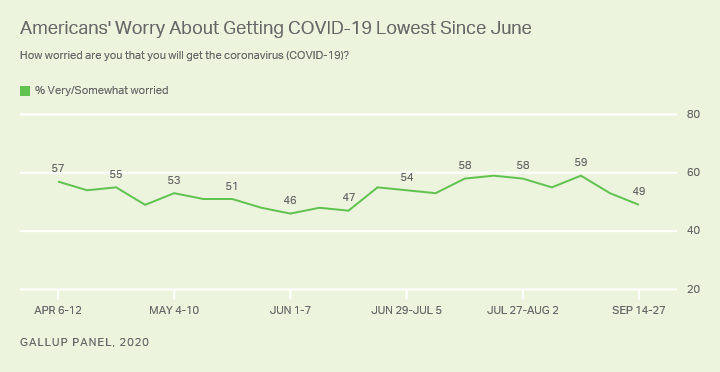
Line graph. Americans worry that they will catch COVID-19. Currently, 49% of Americans are very or somewhat worried about contracting the disease, the lowest point in Gallup's trend since June.
Concern About Availability of Coronavirus Tests at New Low
Americans' levels of concern about the availability of COVID-19 tests and hospital supplies, services and treatments are the lowest in Gallup's trends since April.
One in four Americans (25%) are either very worried (6%) or moderately worried (19%) about the availability of COVID-19 tests in their area, down by more than half from the 60% who said the same when Gallup first asked about the issue in early April. The current low may be due, at least in part, to plans announced by the Department of Health and Human Services in late August to deliver 150 million rapid COVID-19 tests across the country.
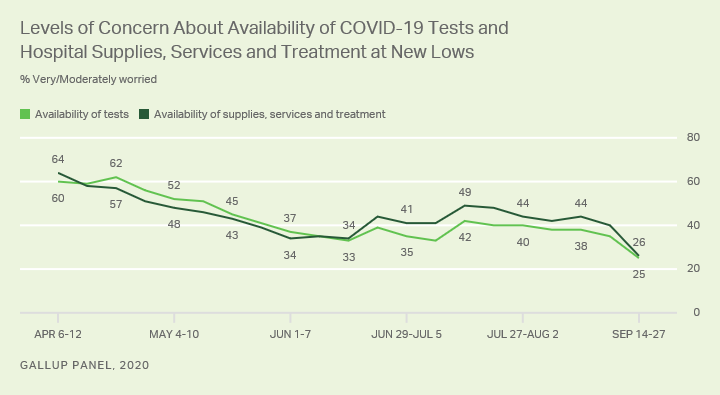
Line graph. Americans' worries about the availability of COVID-19 tests and hospital supplies, services and treatments. Currently, 25% of Americans are very or moderately worried about the availability of COVID-19 tests, the lowest in Gallup's trend. 26% are very or moderately worried about the availability of hospital supplies, services and treatment, again the lowest point in Gallup's trend.
Additionally, about a quarter of Americans (26%) say they are either very worried (5%) or moderately worried (21%) about the availability of hospital supplies, services and treatments in their area. Again, this is less than half of the 64% who registered such levels of concern in April, and down significantly from 49% in mid-July. The decline since July in concern about hospital care corresponds with the drop in daily hospitalizations nationwide to numbers last seen in June.
Americans' Willingness to Take Measures to Avoid COVID-19
Americans' readiness to be vaccinated for COVID-19 has fallen to its lowest point in Gallup's trend since July. Half of Americans (50%) say they would agree to be vaccinated "right now" if an FDA-approved vaccine was available at no cost, down from 66% when Gallup first asked Americans about it in July.
Americans' Readiness to Get COVID-19 Vaccine Falls to 50% (Oct. 12, 2020)
Research conducted Sept. 4-13 in partnership with Franklin Templeton provides deeper insights into Americans' attitudes on efforts to control the spread of the disease. That survey finds 80% of Americans saying they are highly likely to wear a mask tomorrow if they were out of their home and in an indoor space. Mask usage is highest among Americans who believe asymptomatic carriers of COVID-19 can still spread the disease, with 96% of this group saying they have worn a mask when outside their home within the past seven days.
Mask Use Linked to More Accurate Perceptions of COVID-19 (Oct. 7, 2020)
COVID-19's Impact on Work and Consumer Behavior
As the coronavirus pandemic has stretched into the fall, the long-term impact of the disruption it has caused has become apparent through both Gallup's COVID-19 tracking survey and the Franklin Templeton/Gallup research.
Gallup's Sept. 14-27 survey revealed the current state of Americans' remote work habits, with 33% of U.S. workers saying they "always" work remotely to avoid catching or spreading the coronavirus, while 25% say they sometimes do and 42% say they never do. Forty-six percent of U.S. workers say that "all or nearly all employees" at their place of work are currently working on-site. And a majority, 55%, continue to be very or moderately concerned about being exposed to COVID-19 at their place of work.
COVID-19 and Remote Work: An Update (Oct. 13, 2020)
The Sept. 4-13 Franklin Templeton/Gallup survey measured Americans' attitudes on returning to pre-COVID-19 patterns of consumer behavior, such as dining at restaurants, going to gyms or salons, and traveling. This research found links between Americans' confidence in their ability to protect themselves from COVID-19 and their willingness to return to these activities, with adults who are "very confident" that they can protect themselves substantially more likely to resume these activities.
Confidence in Avoiding COVID-19 Linked to Consumer Behavior (Oct. 7, 2020)
COVID-19 Concerns Among Parents
The reopening of schools in the midst of the COVID-19 pandemic has sparked substantial debate over its safety. Nearly half of U.S. parents of children aged 18 or younger (45%) say they are very worried that their child will get COVID-19 at school or day care, with another 27% saying they are somewhat worried.
45% of Parents Very Worried Kids Will Get COVID-19 at School (Oct. 8, 2020)
Differences in COVID-19 Concerns Between Men and Women
Although partisanship is a major differentiator in U.S. attitudes and behaviors related to COVID-19, gender also matters. Women are substantially more likely than men to say they are very or somewhat worried about catching the disease (60% vs. 47%, respectively). Women (79%) are also more likely than men (64%) to say they always wear a mask in indoor settings when social distancing isn't possible.
The COVID-19 Responses of Men vs. Women (Oct. 7, 2020)
____________________________________________________
Oct. 5, 2020
Here is a quick review of Gallup's August and September reports on Americans' assessment of the coronavirus pandemic, their proclivity to visit retailers and spend money, and their views on government leaders' handling of the crisis. The findings are based on Gallup polling conducted before the U.S. surpassed 200,000 deaths in late September and before President Donald Trump and others in his inner circle started testing positive for the virus.
Assessing the Crisis
In late August, as schools and more businesses around the country were starting to reopen, Americans were markedly less negative about the coronavirus situation than they had been over much of the summer. For the first time since early June, less than half thought the situation was getting worse (47%) while more said it was either getting better (30%) or staying the same (23%).
Americans Less Negative in Their COVID-19 Outlook (Sept. 9, 2020)
Attitudes have since improved further, with 42% saying the situation is getting worse and 36% saying it's getting better, based on Gallup polling conducted Sept. 14-27.
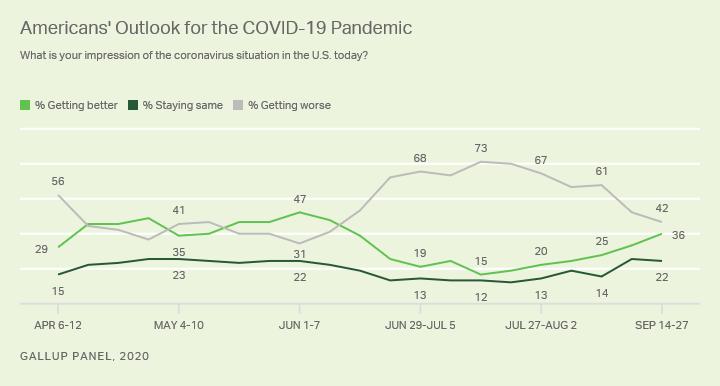
Line graph. Weekly trend since April 6 in Americans belief that the coronavirus situation is getting better or staying the same or getting worse. After improving for much of May and June large majorities in late June and July thought things were getting worse. Since then the negative outlook has sunk below 50% and 36% are optimistic the situation is improving.
U.S. COVID-19 Policies and Leadership
When asked to rate how Trump, the Centers for Disease Control and Prevention (CDC), and their state governor are handling different aspects of the pandemic, Americans are most positive, by far, about their governor.
State governors as a whole are rated best by the American people across three measures of government leadership on the coronavirus or related health challenges, followed by the CDC and, lastly, Trump.
Residents in states led by Democratic governors (61%) are far more likely than those in Republican-led states (47%) to say their governor has communicated a clear plan of action in response to the coronavirus.
How Governors, CDC and Trump Stack Up on COVID-19 (Sept. 15, 2020)

Line graph. Line graph. Ratings of state governors' communication of a clear plan of action in response to the coronavirus since June. Currently, 61% of Democratic and 47% of Republican governors are rated positively for their communication of a clear plan of action.
In August, the Franklin Templeton-Gallup Economics of Recovery Study documented broad bipartisan support for a second wave of economic impact payments to all qualified adults.
Broad Bipartisan Support for Additional Stimulus in U.S. (Sept. 1, 2020)
The Economic and Financial Effects of COVID
Gallup research conducted in partnership with Franklin Templeton reveals that Americans who are currently able to save money are putting most of that surplus cash into their savings accounts rather than adding to retail spending.
When given the opportunity to give multiple answers, 76% of those who are compiling cash reserves right now say they will use it to add to their savings, and another 10% say they will use it to pay off existing debt. About a quarter say they will spend it on "basic goods and/or services," while 13% will spend it on a future vacation or personal travel.
Americans Favor Saving Over Spending Until Vaccine (Sept. 9, 2020)
The Franklin Templeton survey also found no change between July and August in U.S. adults' reports of visiting various types of retail establishments. While the majority said they or a household member had visited a grocery store in the past 48 hours, this was essentially unchanged in August at 57%, versus 56% in July. Recent visits to restaurants (20%), pharmacies (19%), gyms (7%), salons/barbershops (7%) and hotels (6%) were also steady in August.
Consumers' Likelihood to Visit Businesses Stable in August (Sept. 9, 2020)
In line with the stability in consumer behavior, small-business owners' optimism remains subdued according to the Wells Fargo/Gallup Small Business Index. Although the index was improved in August compared with April, it is far from restored to its pre-COVID-19 level at the start of the year. Only 38% of U.S. small businesses report they are "operating as normal."
Small-Business Owners' Optimism Up From April, Below COVID-19 (Sept. 9, 2020)
Long-Term Gallup Work Trends Show COVID-19 Effects
Gallup's July/August 2020 update of its annual Work and Education survey found workers more concerned about layoffs and cutbacks than they were a year ago, as well as less satisfied with their on-the-job safety.
U.S. Workers' Worries Spike Amid COVID's Economic Impact (Sept. 1, 2020)
U.S. Worker Satisfaction With Job Safety Down Amid COVID (Sept. 2, 2020)
An analysis of Gallup work-from-home trends finds only a modest increase since the start of the pandemic in the percentage of workers who have ever telecommuted. But the number of days that these workers say they have worked from home in the past month has more than doubled in the past year. In other words, those who can't telecommute aren't -- but those who can are doing it more than ever.
U.S. Remote Workdays Have Doubled During Pandemic (Aug. 31, 2020)
U.S. Adults' Wellbeing
Americans were doing a bit better emotionally in July than toward the beginning of the pandemic, according to Gallup's life evaluation ratings. The percentage "thriving" in July stood at 52.2%, up from 46.4% in April but still not restored to the 56.1% found pre-COVID-19.
After Record Drop, U.S. Life Ratings Partially Rebound (Aug. 16, 2020)
____________________________________________________
Aug. 19, 2020
Americans' initial hope that the disruption caused by the coronavirus would end quickly has faded. Instead, after five months of living through the pandemic, Americans have come to expect the disruption to last beyond this year. Half expressed this for the first time last week, with the 51% saying so up five percentage points from the prior week.
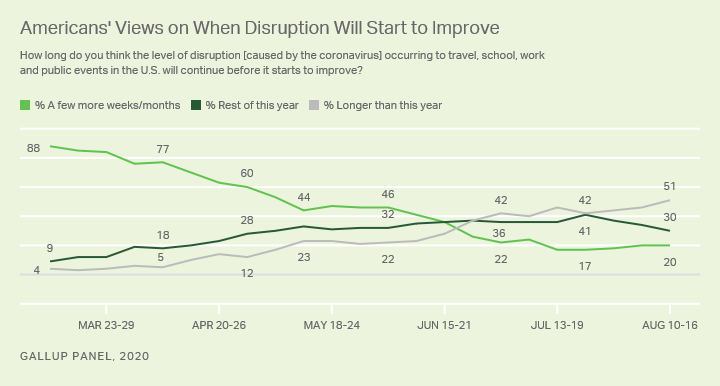
Line graph. Weekly trends since March 13 in Americans perception of length of time it will take before the disruption caused by the coronavirus starts to improve. In March more than 80% thought it would take a few more weeks or months but that gradually declined to roughly 20% in recent weeks. Now the slight majority of 51% think it will take longer than this year.
Gallup's recent articles explore how Americans perceive the seriousness of the pandemic and how they are coping with it in their daily lives.
How Much Americans Worry About COVID-19
Pandemic fears: Americans' belief that the pandemic is getting worse wobbles from week to week but has remained high since the fourth week of June. Gallup's Zach Hrynowski summarized various Gallup indicators of public concern about the pandemic last week, and since then the percentage saying the coronavirus situation is getting worse has held steady at 61%. Fewer -- about four in 10 -- worry about the availability of testing and hospital supplies, and those figures too have since remained the same.
U.S. COVID-19 Outlook Still Negative, but Improving (Aug. 14, 2020)

Line graph. Weekly trend since April 6 in Americans belief that the coronavirus situation is getting better or staying the same or getting worse. After improving for much of May and June Americans outlook turned negative in June and the majority continue to say things are getting worse.
COVID-19 as top problem: After slipping into a tie with race relations and government leadership in June, the percentage of Americans citing the coronavirus as the "most important problem" facing the U.S. jumped 10 points in July and is back in the top spot.
More Americans Cite COVID-19 as Most Important U.S. Problem (Aug. 5, 2020)
Steps Americans Can Take to Protect Themselves
Looking ahead to a vaccine: Gallup recently asked Americans if they would agree to be vaccinated once an FDA-approved vaccine becomes available, and assuming the vaccine is free. Just shy of two-thirds say they would get vaccinated, while about a third say they would not.
One in Three Americans Would Not Get COVID-19 Vaccine (Aug. 7, 2020)
Face masks: Nine in 10 Americans now report wearing a face mask in the past seven days, but people are much more vigilant about "always" or "usually" donning them in indoor settings when they can't socially distance (86%) than in outdoor settings (47%). These data feature strong partisan differences.
U.S. Face Mask Usage Relatively Uncommon in Outdoor Settings (Aug. 7, 2020)
Americans' Comfort With Normal Activities Amongst COVID-19
K-12 education: U.S. parents' preferences for their children's schooling have changed since the end of the 2019-2020 school year. While at that point a slight majority wanted their children to go back to school in person in the fall, today about a third feel this way, with the rest wanting full- or part-time remote learning.
Fewer U.S. Parents Want Full-Time In-Person Fall Schooling (Aug. 3, 2020)
Dining out: The new Franklin Templeton-Gallup Economics of Recovery Study finds that families with children in the household (and possibly in need of diversions) are more willing to venture out to restaurants during the pandemic than are those without children. Also, younger adults are more likely than middle-aged and older adults to report dining out. This research also offers insights into how reducing seating capacity affects people's comfort with engaging in this once ordinary behavior.
Which Americans Are Most Likely to Be Eating Out Again? (Aug. 6, 2020)
Flying: The toll that the pandemic has taken on air travel is also reflected in the new Franklin Templeton-Gallup study. Half of U.S. adults who flew at least once in the past year now say they are not comfortable flying at all. Most of the rest would be comfortable with a short flight of under three hours rather than a longer flight.
52% of U.S. Air Travelers Now Uncomfortable Flying (Aug. 6, 2020)
____________________________________________________
July 27, 2020
The coronavirus pandemic continues to ravage the U.S. -- particularly the Sun Belt states -- and Gallup's ongoing tracking survey finds that Americans' outlook is gloomy. This week's recap highlights recent findings you may have missed or want to revisit.
Americans' Assessment of Pandemic in U.S. Has Deteriorated
Americans have become increasingly pessimistic about the trajectory of the coronavirus pandemic in recent weeks. A record-high 73% of U.S. adults now say the situation in the U.S. is worsening, with a majority saying it is getting a lot worse -- marking a sharp reversal from early June.
U.S. COVID-19 Outlook Deteriorates as Infections Spike (July 24, 2020)
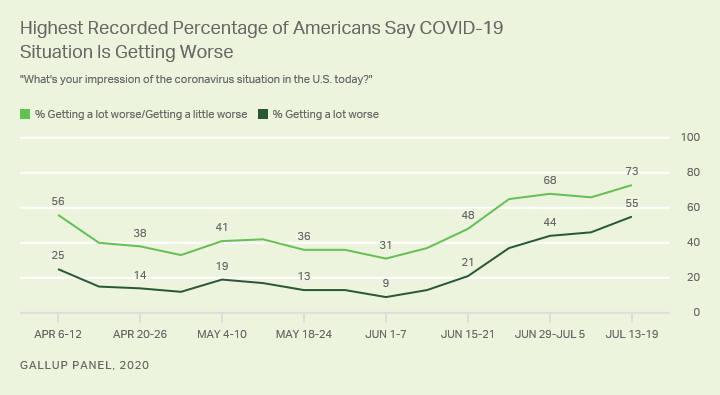
Line graph. Percentage of Americans who believe the coronavirus situation is getting worse. In Gallup's July 13-19 survey, 73% of Americans said the coronavirus situation is getting worse and 55% believe it is getting a lot worse. Both are the highest recorded measures since trending began in April.
Behavior Not Drastically Changed Despite Heightened Negative Assessments
Although Americans believe the coronavirus situation is deteriorating, their contact with non-household members has been steady since June. Less than half of U.S. adults (44%) say they are completely or mostly isolating themselves.
Americans' Social Distancing Steady as Pandemic Worsens (July 20, 2020)
Americans' plateaued social distancing may be the result of increased face mask usage. However, while almost nine in 10 U.S. adults report wearing a mask when in public, new data show that less than half of Americans (44%) always do so. Republicans are particularly less likely to wear masks.
Americans' Face Mask Usage Varies Greatly by Demographics (July 13, 2020)
Republican Governors' Ratings Lower Than Democrats'
Although Americans remain positive overall about the way their state governors are handling the COVID-19 situation, governors' ratings have dipped slightly -- largely due to declining ratings of Republican governors.
GOP Governors Losing Residents' Support on COVID-19 (July 14, 2020)
More U.S. Workers Returning to Workplaces
U.S. employees are returning to their workplaces in greater numbers. According to workers, employers are continuing to clean work sites and increasingly screening workers for COVID-19 symptoms and providing personal protective equipment.
Workplace PPE, Symptom Checks Rise as More Workers Return (July 21, 2020)
Workers in one profession in particular -- K-12 teachers -- are broadly concerned about possible exposure to COVID-19 at their workplace. They are also increasingly likely to say they would prefer to work remotely because of concerns about the virus.
K-12 Teachers Worried About COVID-19 on the Job (July 24, 2020)
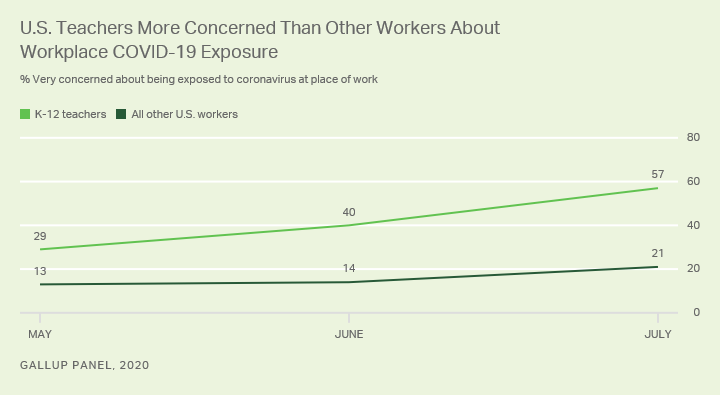
Line graph. Percentages of K-12 teachers and all other U.S. workers who say they are very concerned about being exposed to COVID-19 at their place of work between May and mid-July. Teachers have consistently been more concerned about exposure. Currently, 57% of teachers are very concerned while 21% of all other workers are.
Perspectives on Gallup Findings
Gallup Editor-in-Chief Mohamed Younis recently hosted two podcasts about the coronavirus pandemic in the U.S.
Sonal Desai, chief investment officer at Franklin Templeton Fixed Income, and Jonathan Rothwell, principal economist at Gallup, joined the podcast to discuss the new Franklin Templeton-Gallup Economics of Recovery Study that will track U.S. consumers' readiness to resume pre-COVID-19 activities.
Podcast: What Will It Take to Get the U.S. Economy 'Back to Normal'? (July 23, 2020)
Sera Young, associate professor at Northwestern University, joined the podcast to discuss how the COVID-19 pandemic has exacerbated the global problem of water scarcity.
Podcast: A Crisis Within a Crisis: Water Scarcity Amid COVID-19 (July 17, 2020)
____________________________________________________
July 9, 2020
The number of new COVID-19 cases is surging in the U.S., particularly in Florida, Texas, Arizona and California. As governors in these states grapple with how to proceed, Gallup's COVID-19 research this week finds that the public's outlook on the pandemic remains grim, but partisans' views diverge.
Here are a few notable findings:
One in Five Holding Out for a Vaccine
Americans' views of how soon they would return to their normal day-to-day activities in the absence of government restrictions have evolved over the course of the pandemic and are sharply politically polarized.
At the two ends of the spectrum, 27% would resume their regular activities "right now," and 20% would prefer to wait until after a vaccine is developed. Both of those responses have increased since March.
Meanwhile, reduced percentages would use the number of COVID-19 cases in their state as a guide -- 29% now favor waiting until there are no new cases in their state, and 24% would delay until new cases in their state drop significantly. Both figures are down from 40% in late March/early April.
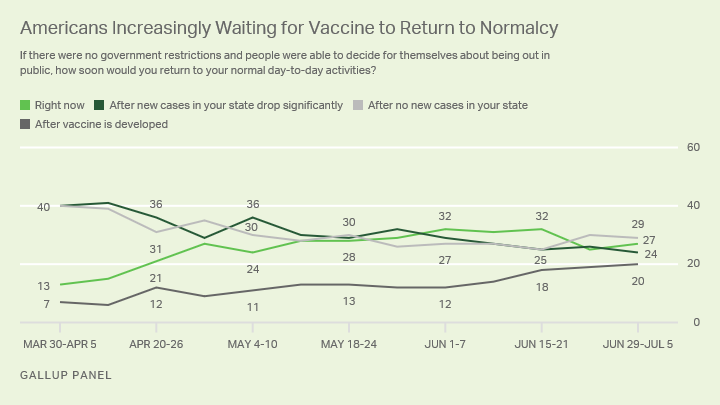
Line graph. Americans' views of how soon they would return to their normal, day-to-day activities in the absence of government restrictions since early April. Currently, 27% would do so right now, 20% would wait for a vaccine, 29% would do so after no new cases in their state and 24% would wait until the number of new cases in their state declines significantly. The percentage of Americans who are waiting for a vaccine is the highest it has been.
Democrats Four Times as Likely as Republicans to Favor Waiting on Vaccine
Preferences for returning to normalcy are sharply different based on party identification. A 59% majority of Republicans currently say they would resume their daily life right now if it were up to them, but far fewer Democrats (4%) and independents (29%) agree.
For their part, Democrats (41%) are far more likely than Republicans (13%) and independents (27%) to say they would want to see no new cases in their state for a while before a resumption of normalcy. Likewise, Democrats (30%) are much more likely than Republicans (7%) and independents (18%) to say they would prefer to wait for a vaccine.
More Pessimism About the Pandemic
A record high expect the current level of disruption to last at least through the end of this year before improving. Thirty-six percent of Americans say it will continue for the rest of the year, and 42% believe it will be longer than that.
Americans' views of the coronavirus situation in the U.S. are the bleakest since Gallup began tracking the measure in early April. A record-high 44% of U.S. adults now say it is getting a lot worse, up seven percentage points in one week, and 24% say it is getting a little worse.

Line graph. Americans impressions of the coronavirus situation in the U.S. since April 6. Currently, 68% say it is getting a lot or a little worse and 19% say it is getting a lot or a little better. Those who say it is about the same are not shown. These are the bleakest readings measured.
July 14 UPDATE: Read Gallup's new report on Americans' frequency of mask wearing and how this differs by party, gender, region and other demographics.
____________________________________________________
July 6, 2020
This week's COVID-19 research finds that as the number of coronavirus infections in the U.S. rises, Americans see the situation as getting worse and are more worried about getting the virus themselves.
Sharp Increase in Percentage Saying Situation Worsening
A new high of 65% of Americans say the coronavirus situation in the U.S. is getting worse, while 23% say it is getting better. Consequently, close to three-fourths of U.S. adults expect the level of disruption caused by COVID-19 to persist until the end of this year or longer than that. A majority of Americans are once again worried about personally contracting the virus.
Assessment of U.S. COVID-19 Situation Increasingly Bleak (July 2, 2020)
Americans More Worried About Lack of Social Distancing
The rise in daily new COVID-19 cases in the U.S. comes as states are attempting to reopen their economies. For the first time, a majority of Americans (54%) say they are worried about the lack of social distancing in their local area. Eighty-six percent of U.S. adults now report wearing a face mask when outside their home, the highest Gallup has measured to date. However, Republicans remain much less likely than Democrats to say they wear a face mask in public.
More Mask Use, Worry About Lack of Social Distancing in U.S. (July 6, 2020)
Renewed Concern About Hospital Capacity, COVID-19 Testing
Gallup observed a steady decline in Americans' worry about the availability of COVID-19 tests and hospital supplies/treatment from early April through late June. However, the most recent data showed an uptick in worry about testing and hospital resources, though the level of concern remains lower than it was in April and early May.
U.S. Concern About Hospital Care Heading Back Up (July 1, 2020)
U.S. Employees Less Engaged in Their Work
Gallup documented a sharp drop in the percentage of U.S. employees classified as engaged in their work. The early June estimate of 31% was down from a record-high 38% measured in late April and early May. Those in leadership and management positions showed some of the largest declines in job engagement.
Historic Drop in Employee Engagement Follows Record Rise (July 2, 2020)
Separately, Gallup documented significant declines in the percentages of U.S. workers who say they feel prepared to do their job, who rate their employer's and manager's communication positively, and who say their organization cares about their wellbeing.
As COVID-19 Continues, Employees Are Feeling Less Prepared (July 2, 2020)
____________________________________________________
June 25, 2020
This week's Gallup research on COVID-19 finds Americans have become increasingly confident that they can protect themselves from getting the coronavirus when out in public. They also have become less pessimistic about the effects of the coronavirus situation on the U.S. economy. A special Gallup analysis shows how news media exposure has shaped COVID-19 prevention attitudes and behaviors.
Self-Protection From COVID-19
Since early April, Americans have become much more confident that they can protect themselves from getting the coronavirus when out in public. The percentage who are "very" or "somewhat" confident has increased by 19 percentage points, with most of that growth coming in the percentage who are very confident. Much of that increase in confidence has come among Republicans.
More in U.S. Confident They Can Protect Self From COVID-19 (June 24, 2020)
Less Pessimism About Harm to U.S. Economy
Far fewer Americans today than in mid-May believe the economy is in a recession or depression. The percentage who say the U.S. is in a depression has been cut by about half in the past month. U.S. adults are also now less pessimistic than they were in May about the effects of the coronavirus situation on their personal finances.
Sharply Fewer Americans Say U.S. in Economic Depression (June 25, 2020)
Media Consumption Habits Influence COVID-19 Attitudes and Behaviors
During the coronavirus pandemic, Americans' attitudes on COVID-19 prevention methods have changed. They have become less likely to believe healthy people should stay at home as much as possible, less likely to say they always practice social distancing, but more likely to say they wear face masks when out in public. The trends in these attitudes and behaviors have varied by party affiliation.
However, Gallup finds that what type of news media people use influences their public health behaviors and attitudes over and above partisanship. Independents and Republicans who rely solely on conservative-leaning news sources are much less likely to endorse and comply with public health recommendations, compared with independents and Republicans who consume only liberal-leaning news or an ideological mix of news sources. The gap between those with right-leaning and non-right-leaning news diets has widened over time. Democrats' attitudes and behaviors are similar regardless of what types of news they consume.
Is the Media Creating Division on COVID-19 Health Practices? (June 23, 2020)
____________________________________________________
June 18, 2020
As the economy continues to reopen and the percentage of U.S. adults practicing extreme social distancing continues to decline, Americans are more optimistic about their personal finances. The majority of parents prefer their children attend full-time, in-person school this fall. Still, Americans' concern about being exposed to the coronavirus shows no signs of easing.
Gauging the Financial Impact
Americans' ratings of their personal finances, and their expectations for their finances going forward, are slightly better now than they were in April when most U.S. adults were still living under stay-at-home orders. Lower-income Americans' ratings have improved more than those among adults living in middle- and upper-income households.
Americans More Upbeat About Personal Finances (June 17, 2020)
Gallup also documented improvements between April and May in Americans' ratings of the U.S. economy more generally. However, the latest update from early June showed no further improvement in assessments of the economy.
U.S. Economic Confidence Still Scarce as Economy Reopens (June 11, 2020)
Looking Back on an Atypical School Year, and Ahead to the Fall
The coronavirus forced schools to shut down and required teachers, students and parents to rely on distance learning methods to complete the 2019-2020 academic year. Parents said the social aspect of distance learning -- being physically separated from teachers and other students -- was the biggest challenge they faced.
As of late May, 29% of parents said school and business closures and social distancing practices were already harming their child's mental health. Another 14% said their child could continue the practices a few more weeks before experiencing harm.
U.S. Parents Say COVID-19 Harming Child's Mental Health (June 16, 2020)
Social Factors Most Challenging in COVID-19 Distance Learning (June 12, 2020)
Parents were more likely to describe remote learning as being "difficult" (56%) rather than "easy" (44%) for their family. The majority, 56%, prefer their children attend school in person on a full-time basis this fall, as opposed to continuing remote learning on a part-time or full-time basis. Parents' preferences are strongly related to their level of concern about their children being infected by the coronavirus.
Parents Slightly Favor Full-Time, In-Person School This Fall (June 18, 2020)
Social Distancing Continues to Ease
A new low of 41% of U.S. adults say they are "completely" or "mostly" isolating themselves from people outside their household. This represents a decline of 18 percentage points in the past month, and 34 points since the peak in late March/early April.
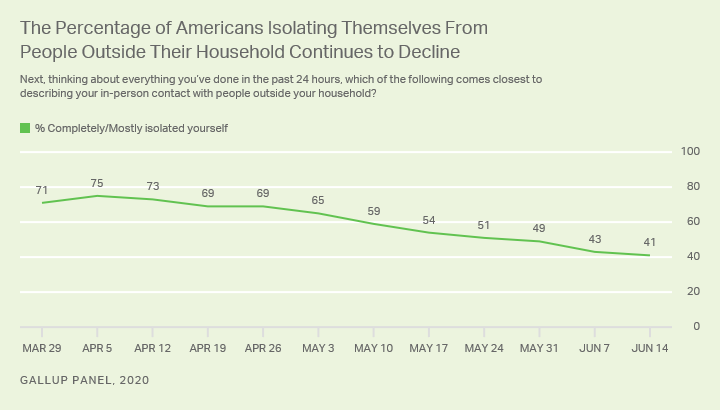
Line graph. 41 percent of Americans in June 2020 say they are completely or mostly isolating from people outside their household. This is down from a high of 75 percent who said the same in April 2020.
Concern About Exposure Shows No Sign of Declining
Public concern about exposure to the disease -- either personally or for a family member -- is little changed from mid-March when cases were rising rapidly in the U.S. and most states were issuing stay-at-home orders. Gallup finds people of color expressing more intense worry than white people.
66% of Americans Remain Worried About Exposure to COVID-19 (June 17, 2020)
____________________________________________________
June 11, 2020
Gallup's latest coverage has documented some key shifts in Americans' views of the COVID-19 crisis.
Heading Back Out Slowly and Carefully
With the number of new cases per day falling slightly in the U.S. in May after peaking in April, fewer Americans reported avoiding public places and small gatherings with friends and family. At the same time, it appears many are still taking precautions such as maintaining six-foot distances (44% say they "always" practice social distancing) and wearing face masks (83%).
Americans Still Social Distancing, but Intensity Is Evolving (June 3, 2020)
Compared with data from early April, Gallup tracking from late May finds that fewer U.S. adults are reluctant to visit their doctor or a hospital for routine treatment should they need it, out of fear of being exposed to the coronavirus.
Concern About COVID-19 at Medical Facilities Drops (June 1, 2020)
Majorities of U.S. employees who are returning to work report vigilant hand-washing and social distancing on the job, as well as the use of personal protective equipment such as gloves and face masks.
Amid Slow Return to Workplaces, COVID-19 Precautions Abound (June 8, 2020)
While one might expect younger people to feel the most comfortable returning to their daily lives, Frank Newport's recent analysis indicates otherwise: "Our data suggest that assumptions about disproportionality of concern among older members, customers and patrons need to be examined closely. Churches and other business organizations may find that the political orientation of their membership and patrons is a more powerful predictor of returning to in-person participation than the members' and patrons' average age."
Age Versus Politics in Determining Virus-Related Attitudes (May 29, 2020)
Limited Improvement in Optimism About Virus Trajectory
Although the number of new cases per day in the U.S. has slowed from its peak, more recently it has stabilized at a level far from optimal. This may explain why Americans have remained hesitant to say the coronavirus situation in the U.S. is getting better. More said so in late May than earlier in the month -- but at 42%, the figure remains below majority level. Another 36% thought the situation was getting worse, while 21% perceived it was staying about the same.
In U.S., More Optimism About Pandemic, Less About Duration (June 3, 2020)
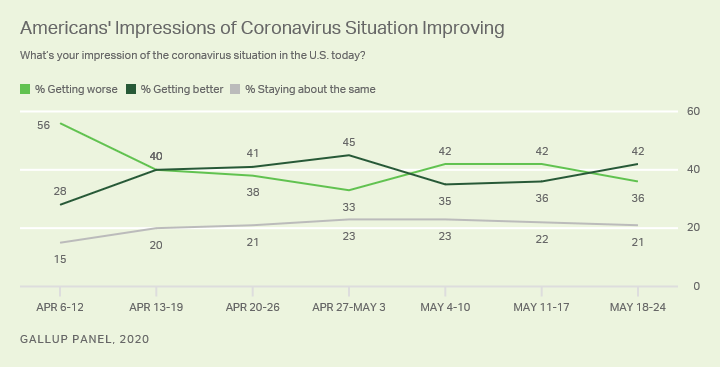
Line graph. Americans impressions of the coronavirus situation are improving. 42 percent of Americans say the situation is getting better, while 36 percent say it is getting worse. Another 21 percent say it is staying the same.
Economic Fallout Still Mounting
Prior to a recession officially being declared last week, seven in 10 Americans thought the country was in a recession or worse, including 30% terming it a depression. Sharp partisan differences are seen on this measure, with most Democrats versus less than half of Republicans perceiving a recession or depression.
In U.S., 71% Believe Economy Is in Recession or Depression (May 29, 2020)
Jonathan Rothwell, Principal Economist at Gallup, explored the impact of coronavirus-related work disruptions on different occupations and income classes and found profound disparities. According to Rothwell, "Workers who provide in-person services have borne the brunt of layoffs and wage reductions, as shown in Gallup data collected from April 17-May 17, 2020. Moreover, those in low-paying jobs are much more likely to have been laid off or seen wage and hour cuts than workers in high-paying jobs."
The Unequal Distribution of Economic Damage From COVID-19 (June 1, 2020)
Take Control of Your Happiness
Finally, as the pandemic wears on and many of us remain mostly bound to our homes, this podcast on maintaining happiness -- hosted by Gallup Editor-in-Chief Mohamed Younis -- is not to be missed.
How can people use life challenges as opportunities for personal progress? Gallup Senior Scientist and Professor of the Practice of Public Leadership at the Harvard Kennedy School, Arthur C. Brooks, joins the podcast to discuss maintaining happiness during a pandemic.
Podcast: How to Maintain Happiness and Wellbeing in Lockdown (May 29, 2020)
____________________________________________________
May 26, 2020
This post-Memorial Day edition catches readers up on everything Gallup published last week through this morning related to COVID-19 coverage. As always, for previous blog entries, scroll past today's update -- or browse all of Gallup's news articles on COVID-19, sorted by topic, here.
Less Worry About Medical Safeguards, Less Social Distancing
Perhaps not coincidentally, fewer Americans report avoiding various situations involving personal contact while fewer also say they are worried about the availability of coronavirus tests and hospital services in their area.
In interviewing for the week ending May 17, Gallup recorded further reductions in the percentages of Americans reporting they were avoiding public places, small gatherings and travel. The analysis by Jeffrey M. Jones points out that even as more people are venturing out, most Americans are still taking precautions and see the value in limiting contact as much as possible.

Custom graphic. May 2020 saw big declines in the percentages of Americans avoid public places, small gatherings and public travel. Currently, 65 percent say they are avoiding public places, while 63 percent are avoiding small gatherings, and 76 percent are avoid travel by plane, subway or bus.
Additional Gallup reports on social distancing provide more insight into the extent to which Americans are isolating themselves and the extent to which they are confident the practice saves lives.
Social Distancing Eases as Some States Lift Restrictions (May 15, 2020)
Most -- but not all -- Americans believe that social distancing saves lives. Gallup's coronavirus tracking poll finds that most Americans are either "very confident" (54%) or "moderately confident" (31%) in this belief.
Americans' Social Distancing Beliefs and Activity (May 19, 2020)
As noted, a shrinking percentage of Americans are worried about the availability of coronavirus tests as well as hospital supplies and services. The percentage worried about each has declined roughly 10 points since late April, and now about half of Americans worry about each issue.
U.S. Concerns About Hospitals, COVID-19 Tests Declining (May 15, 2020)
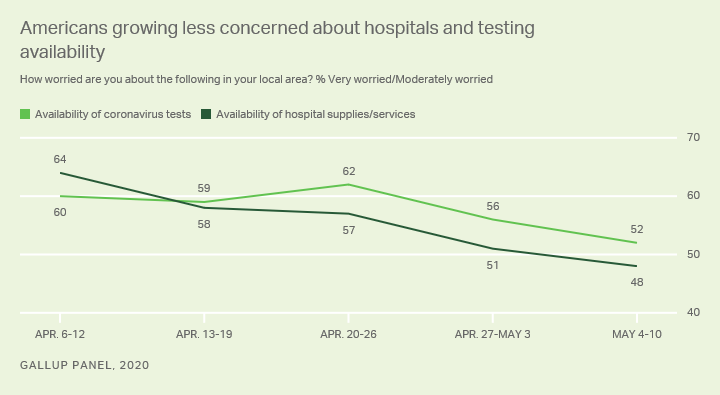
Line graph. 52 percent of Americans are concerned about the availability of coronavirus tests, down from 62 percent last month.
Wary of COVID-19 Hype or Tendency to Downplay
Americans' nuanced view of the situation is evident in this new analysis of Gallup/Knight Foundation data on perceptions of the danger caused by the media either downplaying the risks of COVID-19 or exaggerating them.
Public Sees Harm in Exaggerating, Downplaying COVID-19 Threat (May 26, 2020)
U.S. Emotions Improve, but Satisfaction With Direction of U.S. Remains Low
Americans are reporting improvements in their emotional health. Less than half now say they worried a lot of the previous day -- down from 59% in late March/early April, when Gallup recorded an unprecedented increase in self-reported worry. Meanwhile, boredom has dipped five points, to 41%, and happiness has edged up five points, to 72%.
U.S. Adults Report Less Worry, More Happiness (May 18, 2020)
Though the nation's collective mood has improved, Americans' satisfaction with the direction of the country remains subdued. Just under a third of Americans, 32%, now say they are satisfied with the way things are going in the U.S.
U.S. National Mood Shows Little Improvement in May (May 19, 2020)
Republicans (40%) are much less likely than Democrats (87%) to believe COVID-19 is deadlier than the seasonal flu, according to a recent Gallup/Knight Foundation poll. The trend, possible reasons for the gap and implications are discussed in this analysis by Zacc Ritter.
Republicans Still Skeptical of COVID-19 Lethality (May 26, 2020)
Adapting to New Ways of Shopping, Working, Communicating
Even as fewer Americans are engaged in extreme social distancing, more are taking advantage of low-contact retail and medical services. This analysis by Megan Brenan delves into the trend by key demographics.
Use of Low-Contact Commerce Climbs in U.S. During Pandemic (May 26, 2020)
| March 23-April 5 | April 6-19 | May 11-17 | |||||||||||||||||||||||||||||||||||||||||||||||||||||||||||||||||||||||||||||||||||||||||||||||||
|---|---|---|---|---|---|---|---|---|---|---|---|---|---|---|---|---|---|---|---|---|---|---|---|---|---|---|---|---|---|---|---|---|---|---|---|---|---|---|---|---|---|---|---|---|---|---|---|---|---|---|---|---|---|---|---|---|---|---|---|---|---|---|---|---|---|---|---|---|---|---|---|---|---|---|---|---|---|---|---|---|---|---|---|---|---|---|---|---|---|---|---|---|---|---|---|---|---|---|---|
| % | % | % | |||||||||||||||||||||||||||||||||||||||||||||||||||||||||||||||||||||||||||||||||||||||||||||||||
| Picked up takeout from a restaurant | 26 | 31 | 44 | ||||||||||||||||||||||||||||||||||||||||||||||||||||||||||||||||||||||||||||||||||||||||||||||||
| Used curbside pickup at a store | 19 | 27 | 36 | ||||||||||||||||||||||||||||||||||||||||||||||||||||||||||||||||||||||||||||||||||||||||||||||||
| Had a virtual visit with a doctor | 12 | 16 | 27 | ||||||||||||||||||||||||||||||||||||||||||||||||||||||||||||||||||||||||||||||||||||||||||||||||
| Had food from a restaurant or pizzeria delivered | 13 | 16 | 23 | ||||||||||||||||||||||||||||||||||||||||||||||||||||||||||||||||||||||||||||||||||||||||||||||||
| Had groceries delivered | 11 | 14 | 14 | ||||||||||||||||||||||||||||||||||||||||||||||||||||||||||||||||||||||||||||||||||||||||||||||||
| Had medicine or medical supplies delivered | 4 | 6 | 9 | ||||||||||||||||||||||||||||||||||||||||||||||||||||||||||||||||||||||||||||||||||||||||||||||||
| GALLUP PANEL, 2020 | |||||||||||||||||||||||||||||||||||||||||||||||||||||||||||||||||||||||||||||||||||||||||||||||||||
The percentage of U.S. workers logging in from home instead of an office because of the coronavirus has leveled off, at just above 60%. While Gallup doesn't have an immediate pre-COVID-19 baseline to compare this to, about half as many employees in mid-March said they were working from home because of the pandemic. This analysis by Adam Hickman and Lydia Saad finds that workers are far from united in their readiness or desire to return to work -- in fact, they break into four distinct groups.
Reviewing Remote Work in the U.S. Under COVID-19 (May 22, 2020)
After initially expressing more worry about getting COVID-19 than about experiencing financial hardship from the disruption, Americans now express nearly equal levels of concern about the two risks. Gallup Senior Scientist Frank Newport explores these views, among many other indicators of how Americans are weathering the economic challenges brought on by COVID-19.
Gauging Concerns About Americans' Personal Finances (May 22, 2020)
Social media certainly isn't new, but some Americans are relying on it more during the pandemic, both for news about the coronavirus and for staying connected. This article by Zacc Ritter explores age, gender and partisan differences in reliance on social media platforms.
Americans Use Social Media for COVID-19 Info, Connection (May 21, 2020)
Perspectives on Gallup Findings
Also from Frank Newport: "There is a yawning partisan gap in responses to almost any question about virus-related issues. This is particularly true, and perhaps least surprising, when Republicans and Democrats are asked about overtly political aspects of the situation. … But there are also substantial differences by party in nonpolitical questions about the virus."
The Partisan Gap in Views of the Coronavirus (May 15, 2020)
Is the U.S. heading into a recession or a depression? Ian Bremmer, president of the Eurasia Group and host of "GZERO World with Ian Bremmer," joins The Gallup Podcast.
Podcast: Ian Bremmer: We're Heading Into a Coronavirus Depression (May 19, 2020)
____________________________________________________
May 14, 2020
Gallup's latest reporting on daily life amid the coronavirus pandemic finds some easing of social distancing even as majorities of Americans endorse the value of social distancing for saving lives. The partisan aspect to attitudes on COVID-19 is seen in a Gallup/Knight Foundation article about face mask usage, and it continues to color most of Gallup's coronavirus-related findings.
Resuming Visits With Friends and Family
Earlier this week, Gallup reported the biggest one-week decline in Americans' social distancing since we started tracking these behaviors in mid-March. The percentages of Americans avoiding various forms of public contact have all fallen a few percentage points since mid-April, but there was a six-point drop in the percentage avoiding "small gatherings of people, such as with family or friends" in the week ending May 3.
In U.S., a Small Retreat From Social Distancing (May 11, 2020)
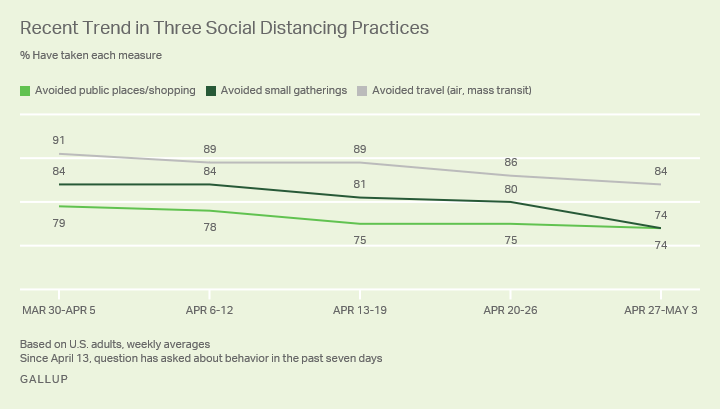
Line graph. Americans adherence to three aspects of social distancing.
It remains to be seen whether resuming in-person visits with the people closest to them will satisfy Americans' need for socialization or be the breach that leads to more social un-distancing. Look for Gallup's update on these metrics next week.
What Americans Need to Get Back to Normal
A new Gallup question finds wide variation in the amount of confidence that different COVID-19 milestones or measures would give Americans to feel safe to resume normal daily activities. The "availability of a vaccine" ranks fourth in importance, but the top three -- involving testing, improved medical therapies and reduced COVID-19 cases -- are less challenging to attain.
Targeted Quarantines Top U.S. Adults' Conditions for Normalcy (May 11, 2020)

Bar graph. Americans views of preconditions for resuming Pre-COVD-19 activities.
Partisan Gaps Dwarf Other Differences on Views of Pandemic
Three Gallup articles this week underscore Republicans' and Democrats' very different perspectives on COVID-19.
These views are highlighted in two articles discussing Americans' confidence that social distancing saves lives and their use of face masks.
Americans Highly Confident Social Distancing Saves Lives (May 8, 2020)
New April Guidelines Boost Perceived Efficacy of Face Masks (May 13, 2020)
Although it touches on partisanship, the piece on face masks mainly addresses Americans' perceptions of the relative value of hand-washing versus the use of masks for preventing illness, including how these views have changed along with official guidelines.
And in a new blog out tomorrow, Gallup contributor Frank Newport takes a comprehensive look at the partisan nature of American attitudes on COVID-19.
Charities Among the Pandemic's Potential Victims
Charitable organizations depend on public altruism, and on individual wealth, to supply the contributions needed to run their organizations, both resources potentially at risk due to disruption from the coronavirus.
A recent Gallup update of trends in charitable activity finds fewer Americans donating and volunteering in the past year. What that potentially means for charitable organizations today is discussed in a blog co-written by Gallup and one of Gallup's Washington, D.C., community partners.
Percentage of Americans Donating to Charity at New Low (May 14, 2020)
COVID-19 Requires Agility From Philanthropic Organizations (May 14, 2020)
While not directly related to Americans' personal philanthropy, an article written by Gallup's wellbeing experts provides additional perspective on the changes to Americans' mindset since the crisis began that could affect their willingness and ability to connect with community organizations.
Worry and Stress Fuel Record Drop in U.S. Life Satisfaction (May 8, 2020)
Gallup/Knight Foundation Work Sheds Light on Media Issues
Local news organizations already on the financial brink are now facing an existential crisis due to revenue loss caused by COVID-19. New data collected in partnership with Knight Foundation show that Americans are supportive of directing federal money to local news organizations as part of coronavirus relief efforts -- although they're much more sympathetic to supporting other community businesses and local residents.
Americans Support COVID-19 Relief for Local News (May 7, 2020)
With a glut of COVID-19 information available from news sources and social media, Americans divide evenly between saying the vast amount of information makes it easier vs. harder to be well-informed.
Americans Struggle to Navigate COVID-19 "Infodemic" (May 11, 2020)
____________________________________________________
May 8, 2020
Readers of Gallup News would not have been surprised to see this morning's BLS announcement that April unemployment was 14.7%. Gallup economist Dr. Jonathan Rothwell's analysis of Gallup employment metrics predicted the rate could be as high as 14.6%, essentially on the money.
Below, you'll find more on those findings and other highlights from Gallup News coverage over the past week on the coronavirus.
An expanding minority of Americans expect the disruption caused by the coronavirus to continue for the rest of 2020 or longer (37%), while a dwindling share say things will start to improve in a matter of weeks (22%). But roughly equal proportions of Americans say the situation is getting better (41%) as perceive it is getting worse (38%), a continuation of the shift recorded a week ago as pessimism about the virus declines.
As Curve Flattens, Americans See Progress but Longer Battle (May 1, 2020)
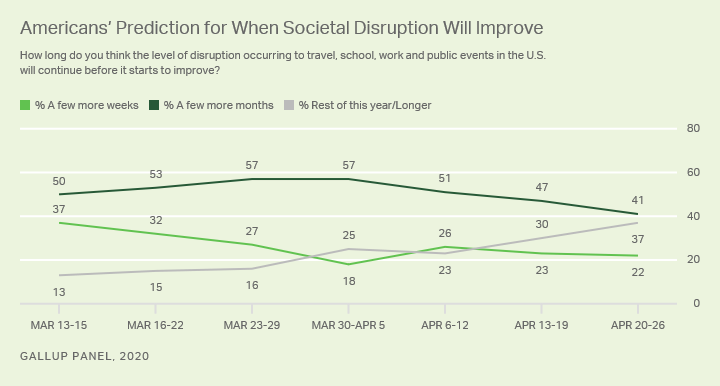
Line graph. Displaying Americans' prediction for when societal disruption will improve.
Americans' vigilance in adhering to social distancing guidelines may be waning. Fewer say they are completely or mostly isolating themselves than did so three weeks ago, and the percentage who say they have been "always" practicing social distancing over the previous 24 hours has slipped.
Americans Still Social Distancing, but Less Vigilant (April 30, 2020)
More than a quarter of Americans (27%) report having worshipped virtually within the past seven days. Another 4% claim to have worshipped in person, despite the coronavirus restrictions in place in most states. The combined 31% who have worshipped within the past seven days either virtually or in person is roughly in line with recent, pre-virus trends.
Update on Virtual Worship in the U.S. During COVID-19 (May 1, 2020)
Unemployment and Other Economic Fallout from COVID-19
Using Gallup Panel data on U.S. workers' employment status during April, Gallup Principal Economist Jonathan Rothwell predicted that the BLS unemployment figure for March would be at or near 15%. Even that underestimates the economic dislocation, as altogether a third of adults in the U.S. labor force have been laid off or seen reduced hours because of COVID-19. That amounts to an estimated 54 million U.S. workers.
Estimating How COVID-19 Affected the Labor Market in April (May 7, 2020)
Fifty-one percent of U.S. adults say they have been spending less money in recent months than they used to, an increase of nearly 20 percentage points from a year ago. The last time a majority of Americans reported spending less than usual was in 2009-2010.
Consumer Spending Pullback Similar to 2009-2010 (May 6, 2020)
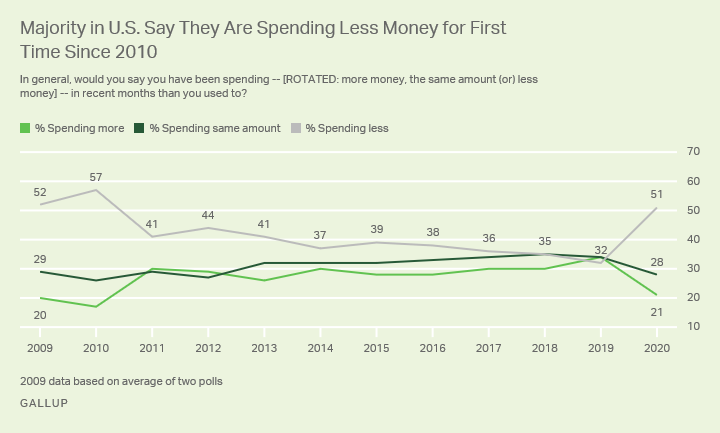
Line graph. Displaying Americans' reports of spending in recent months.
Americans are concerned about the present state of the economy and believe conditions are worsening, but their six-month predictions for specific aspects of the economy are less dire -- particularly in terms of the stock market and economic growth.
Americans Express Mix of Concern and Hope on the Economy (May 4, 2020)
Views on Key Institutions: Trump, Healthcare Providers and the Media
Americans divide evenly when asked whether they approve or disapprove of the way President Donald Trump is handling the coronavirus situation in the U.S. Approval of his handling of the crisis is down 10 percentage points from last month, including a 10-point decline among independents and a 16-point decline among Democrats.
Americans Divided on Trump's Handling of COVID-19 Situation (April 30, 2020)
When it comes to handling the COVID-19 crisis, Americans continue to give their highest approval ratings to healthcare providers and medical experts. Of all the key actors responding to the crisis that Americans were asked about, the news media received the lowest approval (41%) of all.
Health Institutions Still Rated Best for COVID-19 Response (May 1, 2020)
Americans support directing federal money to local news organizations as part of coronavirus relief efforts, something that has bipartisan congressional support. Sixty-five percent are in favor of extending coronavirus relief aid to local news organizations, while 34% are opposed. However, funding local news is a much lower priority for Americans than providing support for local businesses or individuals affected by the coronavirus situation.
Americans Support COVID-19 Relief for Local News (May 7, 2020)
Although attention to national and international news has fallen back to pre-coronavirus levels in recent weeks, attention to local news, though also down, remains higher than before COVID-19. Additionally, more Americans consider themselves to be "very informed" about local issues than did so last year.
Attitudes About Local News Mostly Stable Amid COVID-19 (May 7, 2020)
International Findings on COVID-19
According to a new, globally applicable measure developed by the World Food Programme and Gallup, women are likely to be affected differently than men by acute food insecurity during the COVID-19 pandemic.
Food Insecurity Risks Greater for Women in COVID-19 Crisis (May 5, 2020)
Perspectives on Gallup Findings
How has Americans' wellbeing been affected by the COVID-19 outbreak? And what impact has the crisis had on how people rate their current lives and their anticipated futures?
Podcast: How Badly Has the Coronavirus Impacted U.S. Wellbeing? (May 7, 2020)
____________________________________________________
April 23, 2020
Gallup research this past week based on recent data from the Gallup Panel and Gallup's annual Economy and Personal Finance poll has an "on the one hand, on the other hand" feel to it.
On the one hand, there are some signs of decreased pessimism and indications that Americans are weathering the crisis fairly well:
Americans are sensing some improvement in the national battle to slow the spread of the novel coronavirus outbreak.
U.S. Adults Now Divided on Status of COVID-19 Situation (April 22, 2020)
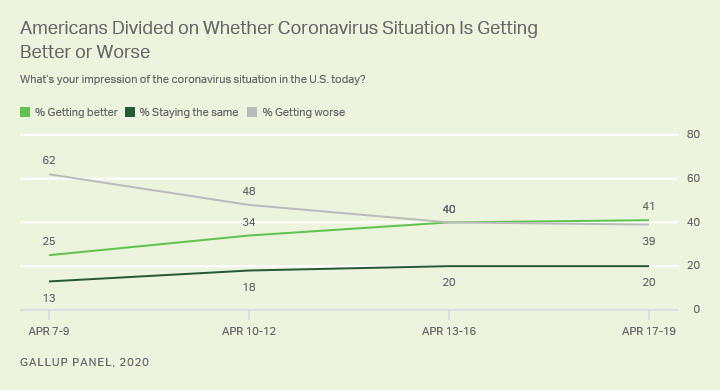
Line graph. Percentage of Americans perceiving the coronavirus situation is getting better, getting worse or staying the same. Weekly averages in April.
They are also feeling a bit less negative about their local hospitals' capacity to serve patients (although not about the availability of testing).
U.S. Public Concern About Hospital Capacity Eases Slightly (April 22, 2020)
Americans' reports of their current financial situation are largely intact compared with a year ago, suggesting that the immense economic disruption taking place nationally hasn't yet transferred to most individuals.
U.S. Personal Finances: Future More Concerning Than Present (April 21, 2020)
Americans are currently more worried about contracting the illness than experiencing severe financial hardship as a result of the disruption caused by the coronavirus.
In U.S., More Fear COVID-19 Illness Than Financial Harm (April 16, 2020)
On the other hand, there are signs of increased anxiety and persistent concern that the crisis is far from over:
COVID-19 dominates what Americans are thinking about when asked to name the most important problem facing the country.
COVID-19 Quickly Becomes Most Important U.S. Problem (April 21, 2020)
Americans aren't easing up on social distancing, suggesting that fear of contracting the illness remains a key factor in their willingness to reopen society.
| Completely | Mostly | Partially | A little | No effort | |||||||||||||||||||||||||||||||||||||||||||||||||||||||||||||||||||||||||||||||||||||||||||||||
|---|---|---|---|---|---|---|---|---|---|---|---|---|---|---|---|---|---|---|---|---|---|---|---|---|---|---|---|---|---|---|---|---|---|---|---|---|---|---|---|---|---|---|---|---|---|---|---|---|---|---|---|---|---|---|---|---|---|---|---|---|---|---|---|---|---|---|---|---|---|---|---|---|---|---|---|---|---|---|---|---|---|---|---|---|---|---|---|---|---|---|---|---|---|---|---|---|---|---|---|
| % | % | % | % | % | |||||||||||||||||||||||||||||||||||||||||||||||||||||||||||||||||||||||||||||||||||||||||||||||
| Apr 13-19 | 24 | 45 | 18 | 8 | 4 | ||||||||||||||||||||||||||||||||||||||||||||||||||||||||||||||||||||||||||||||||||||||||||||||
| Apr 6-12 | 27 | 47 | 17 | 7 | 3 | ||||||||||||||||||||||||||||||||||||||||||||||||||||||||||||||||||||||||||||||||||||||||||||||
| Mar 30-Apr 5 | 28 | 47 | 17 | 6 | 3 | ||||||||||||||||||||||||||||||||||||||||||||||||||||||||||||||||||||||||||||||||||||||||||||||
| Mar 23-29 | 25 | 46 | 19 | 8 | 3 | ||||||||||||||||||||||||||||||||||||||||||||||||||||||||||||||||||||||||||||||||||||||||||||||
| Mar 16-22 | 18 | 40 | 22 | 13 | 7 | ||||||||||||||||||||||||||||||||||||||||||||||||||||||||||||||||||||||||||||||||||||||||||||||
| Response options: 1) Completely isolated yourself, having no contact with people outside your household; 2) Mostly isolated yourself, having very little contact with people outside your household; 3) Partially isolated yourself, having some contact with people outside your household; 4) Isolated yourself a little, still having a fair amount of contact with people outside your household; 5) Did not make any attempt to isolate yourself from people outside your household | |||||||||||||||||||||||||||||||||||||||||||||||||||||||||||||||||||||||||||||||||||||||||||||||||||
| Gallup Panel, 2020 | |||||||||||||||||||||||||||||||||||||||||||||||||||||||||||||||||||||||||||||||||||||||||||||||||||
There is significant anxiety about the future when it comes to personal finances, with half of Americans saying their financial situation is worsening.
U.S. Personal Finances: Future More Concerning Than Present (April 21, 2020)
Unemployment, specifically, is rattling people, with a quarter saying it's likely they could be laid off within the next year.
Record-High 25% of U.S. Workers Say Job Loss Is Likely (April 22, 2020)
Important Research on Social Distancing
In addition to the above findings, Gallup News this past week featured an article by Gallup Senior Economist Jonathan Rothwell analyzing the precise number of people that Americans are coming into contact with. It shows that while most Americans are broadly engaged in social distancing, some people are able to isolate themselves far more than others.
The eye-popping statistic is that those who report they are "mostly" isolating themselves generate about five interpersonal contacts per day, compared with an average of 52 among those not attempting to isolate themselves. Going to work plays a big role in how well people are able to isolate themselves, as do efforts by workplaces to mitigate social contact among workers.
Americans' Social Contacts During the COVID-19 Pandemic (April 21, 2020)
A New Normal Emerging in Retail and Healthcare?
Americans have been gradually increasing their use of grocery delivery, curbside pickup and virtual doctor visits since March, with most of them saying they will continue to rely on these and other low-contact services after the national lockdown ends.
Increased Use of Low-Contact Services May Prove Permanent (April 23, 2020)
____________________________________________________
April 16, 2020
Gallup is continuously polling Americans about the COVID-19 situation to understand their views and experiences on diverse aspects of the crisis. In addition to tracking numerous metrics daily by web using our probability-based Gallup Panel survey, we are monitoring other dimensions using our nationally representative telephone polls.
Here's what we've learned in the past week:
Relief Money Is Essential for Half of Americans
Government relief payments can't come soon enough for the 35% of Americans who say they will use the money to pay bills and the 16% who will spend it on essentials like food and gas.
Half in U.S. Plan to Spend Relief Money on Bills, Essentials (April 14, 2020)
Americans Are Prioritizing Health Over 'Normalcy'
Two articles this week underscore Americans' commitment to social distancing. U.S. adults are maintaining peak levels of separation from non-household members and plan to keep doing so until it's clearly safe to resume their normal daily activities.
Read about the percentages avoiding small gatherings, public places and travel throughout the crisis:
Social Distancing Efforts Have Cemented Into U.S. Life (April 13, 2020)
Learn who is eager to get back to normal quickly after the government lifts restrictions and who would rather wait for stronger indications that it's safe to do so:
Americans Remain Risk Averse About Getting Back to Normal (April 14, 2020)
| March 27-29 | April 3-5 | ||||||||||||||||||||||||||||||||||||||||||||||||||||||||||||||||||||||||||||||||||||||||||||||||||
|---|---|---|---|---|---|---|---|---|---|---|---|---|---|---|---|---|---|---|---|---|---|---|---|---|---|---|---|---|---|---|---|---|---|---|---|---|---|---|---|---|---|---|---|---|---|---|---|---|---|---|---|---|---|---|---|---|---|---|---|---|---|---|---|---|---|---|---|---|---|---|---|---|---|---|---|---|---|---|---|---|---|---|---|---|---|---|---|---|---|---|---|---|---|---|---|---|---|---|---|
| % | % | ||||||||||||||||||||||||||||||||||||||||||||||||||||||||||||||||||||||||||||||||||||||||||||||||||
| Immediately | 22 | 20 | |||||||||||||||||||||||||||||||||||||||||||||||||||||||||||||||||||||||||||||||||||||||||||||||||
| Wait to see what happens with the coronavirus before resuming | 69 | 71 | |||||||||||||||||||||||||||||||||||||||||||||||||||||||||||||||||||||||||||||||||||||||||||||||||
| Continue to limit your contact with other people and daily activities indefinitely | 9 | 10 | |||||||||||||||||||||||||||||||||||||||||||||||||||||||||||||||||||||||||||||||||||||||||||||||||
| Gallup Panel, 2020 | |||||||||||||||||||||||||||||||||||||||||||||||||||||||||||||||||||||||||||||||||||||||||||||||||||
Crisis Is Taking a Toll on Emotions
The percentage of Americans classified as "thriving" has dropped to the lowest level seen since the Great Recession. Similarly, self-reported feelings of stress and worry are up, while enjoyment is down.
In U.S., Life Ratings Plummet to 12-Year Low (April 14, 2020)
Although majorities of Americans say they can endure social distancing practices and business/school closures for "as long as is necessary" when it comes to their finances and physical health, they are less sure their emotional or mental health will last more than a few more months.
Americans Say COVID-19 Hurting Mental Health Most (April 15, 2020)

Bar graph. Americans' views of how long they can follow social distancing before finances, mental and physical health suffer.
Online Shopping and Curbside Pickup Gaining Users, but Slowly
Relatively few Americans say they are using low-contact means of getting food, groceries and other supplies into their home more often than they did before the crisis. However, a few services may be catching on as the national lockdown wears on. In particular, increasing percentages say they are using grocery delivery (14%) and curbside pickup (22%) more often than did so the week prior. Younger and higher-income adults are at the vanguard of using these and other low-contact services.
Americans Slow to Adopt Low-Contact Services Amid Crisis (April 9, 2020)
Read all of Gallup's COVID-19 Data Briefs:
- Gallup's Data Brief on COVID-19 (March 31, 2020)
- Gallup COVID-19 Data Brief No. 2 (April 2, 2020)
- Gallup COVID-19 Data Brief No. 3 (April 7, 2020)
- Gallup COVID-19 Data Brief No. 4 (April 10, 2020)



